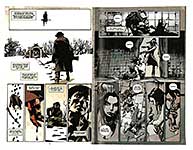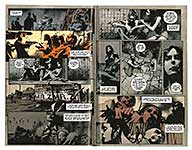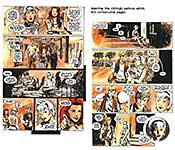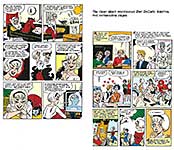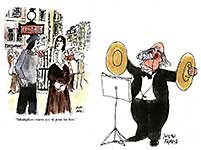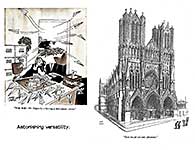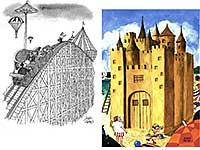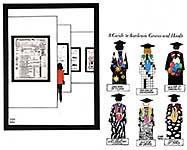 |
|||||||||||||||
Opus 337: (February 12, 2015). We wind up coverage of the horrendous Charlie Hebdo killings by examining issues of freedom of expression vs. offensiveness in U.S., Palestine, Israel, Angouleme, and Malaysia, then we advocate unfettered free speech everywhere. This opus began at the end of December as our year-end review, a sort of holiday edition, but it has been delayed whilst we attend to Charlie Hebdo and the attendant complications. Nothing wroth, we plunge ahead now with the original notion, reviewing the past year with a round-up of the top stories of 2014 as depicted in editoons. Other topics include Sandy Eggo moving (?), terrible WuMo, and reviews of Lunar Park and Sabrina, plus Word of the Year, and obits for comics historian Cole Johnson and New Yorker cartoonist Joseph Farris. This is a fairly large posting, so we encourage you to pick the topics you’re interested in from the list below. Here’s what’s here, by department, in order—:
CORRECTIONS A Story for Storytellers
NOUS R US DC Comics Cuts Line-up Comic-Con Leaving San Diego? The New Yorker Moves South Top Shelf and IDW Join Forces Word of the Year Name of the Year Forbidden Words
National Cartoonists Society Reuben Agenda Mort Drucker Honored
Cartooning at the White House
MORE CHARLIE AFTERMATH Muslim-American Cartoonist’s Opinions Muhammad Cartooned—Yea or Nay No Freedom of Expression in Palestine No Muhammad in Israel Je Suis Charlie at Angouleme Malaysian Authorities Harass Zunar Free Speech Fundamentalistis Hypocritical Double Standard for Free Speech? Summing Up for Free Speech Cartoonists Forced into Exile
EDITOONERY Top Newsstories of the Year in Cartoons
RANCID RAVES GALLERY A Famous Picture by Norman Rockwell Harv’s Post-Grad Ads
NEWSPAPER COMICS PAGE VIGIL Oddities and Taboo Violations in the Funnies WuMo, A Terrible Joke
CIVILIZATION’S LAST OUTPOST Super Bowl Pig Out NRA Fosters Fear
LONG FORM PAGINATED CARTOON STRIP Lunar Park Graphic Novel
BOOK MARQUEE Howard the Duck Descender the Movie Already
FUNNYBOOK FAN FARE Sabrina
PASSING THROUGH Cole Johnson Joseph Farris
Our Motto: It takes all kinds. Live and let live. Wear glasses if you need ’em. But it’s hard to live by this axiom in the Age of Tea Baggers, so we’ve added another motto:.
Seven days without comics makes one weak. (You can’t have too many mottos.)
And our customary reminder: don’t forget to activate the “Bathroom Button” by clicking on the “print friendly version” so you can print off a copy of just this installment for reading later, at your leisure while enthroned. Without further adieu, then, here we go—:
CORRECTIONS As always, pervasive and immutable as Truth itself, our policy is to put the corrections up front where they can’t be missed. (Ditto, of course, admission of error.) First, a confession of my abject ignorance. I professed last time not to know what “DIY” meant. I was thinking it must mean something peculiar and/or wonderful in South Africa, where the cartoon in which it appeared (one of Zapiro’s) was published. Alas, not so. It apparently means the same there as it does here: Do It Yourself. I
also posted the cartoon that appears here at your eye’s elbow and interpreted
it wrongly, becoming myself, in effect, an object lesson of exactly the sort of
misapprehension that I was sermonizing against. On the basis of just this much information, I concluded, erroneously as it turns out, that the cartoon ridicules Muslim dietary devotions by showing that even if Muslims normally avoid pork, they’ll abandon that principle under the right circumstances—in this case, crass monetary considerations. Even my attempt, here, to show that a seemingly Islamophobic cartoon wasn’t, actually, about Muslim sex practices fell into quite another trap. Thanks to Matthias Wivel at tcj.com, I finally apprehended the cartoon’s actual import. The external context of the cartoon jerks us back to a more accurate reading. The cartoon refers to the Islamophobic film “Innocence of Muslims” that circulated throughout the Muslim world in the summer and fall of 2012, resulting in a violent uproar and over 50 deaths, including that of the American ambassador in Benghazi. The target of the satire is the rank amateurism of the film’s makers: they are so unprofessional that they cannot afford the presumably essential actress for playing the part of Muhammad’s youngest wife. Typically, Charlie (in this case, the cartoonist Charb) goes over the top to insert digs and jabs not necessary to the satirical joke—the digs at the diet of devout Muslims and at the Prophet’s having an under-age wife. As Wivel says at tcj.com: “One must remember that Charb is satirizing chauvinist filmmakers and thus depicting their conception of Islam as reflected in their idiotic film.” But the offensiveness of the superfluous accouterments overwhelms the satire with its maliciousness. Still, understanding the context of this cartoon helps to preserve its claim to satire. And now, at last, on to the “news.” But first, this—:
A Good Story for the New Year WHEN the great Rabbi Israel Baal Shem-Tov saw misfortune threatening the Jews it was his custom to go into a certain part of the forest to meditate. There he would light a fire, say a special prayer, and the miracle would be accomplished and misfortune averted. Years later, when his disciple, the celebrated Magid of Mezritch, had occasion, for the same reason, to intercede with heaven, he would go to the same place in the forest and say: "Master of the Universe, listen" I do not know how to light the fire, but I am still able to say the prayer." And again the miracle would be accomplished. Still later, Rabbi Moshe-Leib of Sasov, in order to save his people once more, would go into the forest and say: "1 do not know how to light the fire, I do not know the prayer, but I know the place and this must be sufficient." It was sufficient and the miracle was accomplished. Then it fell to Rabbi Israel of Rizhyn to overcome misfortune. Sitting in his armchair, his head in his hands, he spoke to God: "I am unable to light the fire and I do not know the prayer; I cannot even find the place in the forest. All I can do is to tell the story, and that must be sufficient." And it was sufficient—because God loves stories. — Hasidic tale told by Elie Wiesel
NOUS R US Some of All the News That Gives Us Fits
DC COMICS CUTS LINE-UP DRASTICALLY But Only Temporarily Almost half the publisher's output is being cancelled at the end of March, reports Matt Kamen at wired.co.uk. Here are the titles ending: Aquaman and the Others; Arkham Manor; Batwoman; Green Lantern Corps; Green Lantern: New Guardians; Infinity Man and the Forever People; Klarion; Red Lanterns; Secret Origins; Star Spangled War Stories; Swamp Thing; Trinity of Sin; Worlds' Finest; and weekly titles Batman Eternal, Futures End and Earth 2: World's End. “With the latter three shipping four to five issues per month,” said Kamen, “the culling accounts for 25 of the 52 comics DC has committed to publishing since launching its New 52 revamp in 2011. Video game tie-in series Injustice: Gods Amongst Us Year Three also ends in March, but isn't part of the New 52 line-up.” After this startling overture, Kamen goes on to explain that “technically, everything DC publishes is ending in March. For April and May, the entire line is replaced with an event called Convergence.” This hiatus coincides with DC’s move from “its ancestral home in New York City” to California, where the comic book publisher will take up residence at the Burbank offices of its parent company Warner Bros. Reducing the workload for a couple of months will give the comic book staff time to move in and set up. Convergence will see 40 two-issue mini-series “starring characters and teams from across the company's disparate continuities brought into conflict,” said Kamen. “Once the storyline is concluded— and DC's staff are comfortably ensconced on the other side of the U.S.— it is expected that the surviving titles will return in June.” Kamen’s speculation, however, was upended a few days later at Newsarama.com, where, according to Veneta Rogers, everything DC will be different after Convergence: “Beginning in June, DC Entertainment is de-emphasizing continuity and scrapping the New 52 branding of its superhero comics line” to launch a “bold new direction for the DC Universe” and a slew of new titles it's calling “inclusive,” "contemporary," and "accessible." Rogers goes on, quoting DC co-publisher Dan Didio: “In this new era of storytelling, story will trump continuity as we continue to empower creators to tell the best stories in the industry. “In June,” Rogers continues, “DC reports it will publish 24 new No.1 issues to join 25 already-existing comics that will continue from their March numbering for a total of 49 titles. New titles will be added to the line throughout the year. DC's new line will introduce some new creators to DC, like Ming Doyle and Gene Luen Yang, while also bringing back some familiar faces, like Garth Ennis and Bryan Hitch.”
WILL THE COMIC-CON MOVE? ONCE AGAIN, the Comic-Con International San Diego is contemplating a move away from its home for the past 40 years. The Con mulled over the opportunities once before—a couple years ago—but was finally persuaded to sign a contract with the San Diego Convention Center through 2016. Now, as the end of that contract approacheth, the Con is being courted again by Los Angeles and Anaheim. San Diego, for whom the Con is its Super Bowl (saith Joe Terzi, prez and CEO of the San Diego Tourism Authority), no longer has a convention venue large enough for the Con. And that was the bone of contention before. For several years, the Con has been limited to about 130,000 registrants because the Convention Center turns into a fire hazard if more people are permitted to throng through its hallways and exhibits. The Con was persuaded to stay in San Diego when the city announced that it would expand the Convention Center. But that plan hit a snag last summer, reported Hugo Martin and Tony Perry at latimes.com: “The $520-million expansion lost momentum when a state appeals court ruled against a financing plan that would allow hotels around the convention center — instead of voters — to decide on a tax increase to pay for the project. San Diego Mayor Kevin Faulconer has vowed to find another way to finance the expansion.” But he hasn’t yet, and it’s been six months or more. “Still, Faulconer faces another problem. The San Diego Chargers are pushing to have a new stadium built several blocks from the existing Convention Center, in a combined stadium and convention center expansion site. Without a new stadium, the Chargers might move to Los Angeles. But the politically powerful hotel industry opposes the Chargers plan for a combination facility. In the past, Comic-Con officials have sided with the hoteliers in favoring an expansion that is contiguous, not several blocks away.” The Con is big business for San Diego: “Last year, its 130,000 attendees accounted for 60,960 room nights and generated $177.8 million for the local economy.” In the world of conventions, every dollar that a visitor to a city spends has a multiplier effect of x7 on the local economy. No wonder Los Angeles and Anaheim, sensing a crisis approaching, have begun circling again. "The proposals we've received are pretty amazing," said David Glanzer, a spokesman for Comic-Con International. "It's not an easy decision." In its bid, Los Angeles promotes its proximity to the Hollywood studios that film many of the movies and television shows that are featured at Comic-Con. Plus, the convention center is adjacent to L.A. Live, a commercial district brimming with clubs, restaurants and shops. But San Diego has the lively Gaslamp district, also brimming. Both Los Angeles and Anaheim have larger convention centers than San Diego, but Los Angeles' biggest problem is a shortage of hotel rooms within walking distance of its convention center: fewer than 5,000 hotel rooms within a mile of the convention center, with only an additional 2,000 or so rooms under construction. Meanwhile, Anaheim has more than 13,000 hotel rooms within a mile of the convention center. San Diego has about 11,000 rooms within walking distance—plus several hundred more in Mission Valley, a trolley-car ride away. “Anaheim may be the most attractive suitor,” say Martin and Perry, “— because it can offer the largest exhibit hall space in the region — 815,000 square feet — plus proximity to Disneyland and Disney's California Adventure Park. In addition, the Anaheim Convention Center already hosts a smaller gathering organized by Comic-Con International known as Wondercon.” Still, my bet is that the Con will stay in San Diego—for a very simple reason: most of its staff lives in San Diego, and they probably don’t relish the idea of managing a big convention as far from home as Anaheim. They’ll miss a bet, though, if they can’t leverage the competition to get the San Diego hotels to lower room rates. They think that they did it last time, but they didn’t. Not by much. Not enough to justify leaving $177.8 million behind in the city’s economy.
AND, SPEAKING OF MOVING—: THE NEW YORKER ended the first month of the new year by moving. For the last 15 years, the magazine that Harold Ross founded in 1925 has had its offices at 4 Times Square; effective February 1, it joins its parent company, Conde Nast, at 1World Trade Center. This is only the fifth home for the 90-year-old magazine. When Ross launched the first issue (dated February 21, a date commemorated every year the last week of February with an anniversary issue, usually reprinting the first issue’s cover, a Rea Irvin drawing of a supercilious 19th century boulevardier), the office was at 25 West 45th Street. Until now, the magazine has always resided in a mid-town office: in 1935, it moved to 25 West 43rd Street, where it remained for over 50 years until 1989, when it moved a few doors down the block to 20 West 43rd Street. In 1999, it moved to the location it has just abandoned to move decidedly south, far away from the old neighborhood. On
the cover of the February 2 issue, artist Bruce McCall celebrates the
move with a picture showing the Editorial staff on a flatbed heading south to
the new World Trade Center skyscraper in the distance, some of the famous Times
Square signs marking aspects of the magazine’s history. “Dubuque” on the side of a building refers to Ross’s notorious Prospectus for the magazine. Circulated in the fall of 1924 to drum up financial support, the Prospectus described the magazine as “a reflection in word and picture of metropolitan life”—life in New York, the life led by sophisticated readers. It would not be a national magazine; it would not be edited “for the old lady in Dubuque.” The imaginary “dowager Iowan” was revived in the first review of The New Yorker’s inaugural issue: Briton Hadden, Henry Luce’s partner in founding Time, which started two years before Ross’s magazine and worked out of offices one floor below, handed the first issue to one of his writers, Niven Busch, telling him to consider what the old lady in Dubuque might think of it. Busch’s old lady was an accomplished vivisectionist: “I
and my associates here, have never subscribed to the view that bad taste is any
the less offensive because it is metropolitan taste. To me, urbanity is the
ability to offend without being offensive, to startle composure and to deride
without ribaldry. The editors of The New Yorker are, I understand,
members of a literary clique. They should learn that there is no provincialism
so blatant as that of the metropolitan who lacks urbanity.” Ross would later hire Busch. And in 1936, he would publish a scathing profile of Luce by Wolcott Gibbs, which famously parodied Timestyle’s idiosyncratic inverted sentence structure—“Backward ran sentences until reeled the mind”—ending, “Where it all will end, knows God_” On the back of the flatbed is an allusion to something not peculiar to the magazine. The Collyer Brothers were bachelors who lived in a mansion in Manhattan. One of them became blind, and the other began collecting magazines and newspapers and storing them in the mansion against the day when his brother would regain his sight and want to catch up on the events that had transpired during his blindness. Over the ensuing years, the rooms and hallways in the house were piled with towering stacks of periodicals. One of the brothers eventually died, and the other was found crushed under an avalanche of magazines and newspapers. The allusion was, perhaps, to the sort of detritus that someone accumulates in his office over the years of his residing in it—books, magazine and newspaper clippings, all possible fodder for some future article. As Nick Paukmgarten says in this issue’s Talk of the Town, an “accretion of intention.” Exactly the situation here at the Rancid Raves Intergallactic Wurlitzer. The expression too exquisite a bon mot for me to leave it buried forever in an expired issue of one of my favorite magazines. (Favored because it, like Playboy, publishes cartoons. Yes, cartoons, kimo sabe, not centerfolds. Although who can overlook a centerfold?)
TOP SHELF AND IDW JOIN FORCES IN A MAJOR ACQUISITION in the comics marketplace, IDW Publishing has acquired Top Shelf Productions, a highly regarded independent comics house, reported Calvin Reid at publishersweekly.com. Founded by Chris Staros and Brett Warnock, Top Shelf publishes graphic novels with an impressive list of bestselling creators that includes Rep. John Lewis (March); Alan Moore and Eddie Campbell (From Hell); and Craig Thompson (Blankets). According to a statement released by IDW, Top Shelf will “remain a distinct imprint within IDW.” Cofounder Chris Staros will continue with the company as editor-in-chief of Top Shelf Productions, while his longtime partner Brett Warnock will leave Top Shelf to focus on a new business venture outside of comics. The Top Shelf staff—including publicist and marketing director Leigh Walton, designer/digital director Chris Ross, and warehouse manager Zac Boone—will remain in place at the company’s current offices in Marietta, Georgia. A news release from Top Shelf said IDW's main role will be the support and management of Top Shelf's infrastructure—production, sales, marketing and promotional initiatives. IDW will also provide additional funding to secure new breakout projects so that Top Shelf can direct their full attention to producing fan-favorite award-winning books.
WORD OF THE YEAR EVERY YEAR SINCE 1990, the American Dialect Society has convened to pick a word or phrase that has become prominent (i.e., “on everyone’s lips”) during the previous year, denominating the choice as “word of the year.” For 2014, ADS has selected #blacklivesmatter as the Word of the Year for 2014, the first Twitter hashtag to be picked. “Hashtag” itself was the WotY for 2012. In a companion vote, sibling organization the American Name Society voted “Ferguson” as Name of the Year for 2014 in its tenth annual name-of-the-year contest, recognizing the significance of the Missouri town as a flashpoint for protests after the killing of Michael Brown. The ADS vote is the longest-running such balloting anywhere, proclaims the ADS news release—the only vote not tied to commercial interests. It is fully informed by the members’ expertise in the study of words, but it is far from a solemn occasion. “Members in the 125-year-old organization include linguists, lexicographers, etymologists, grammarians, historians, researchers, writers, editors, students, and independent scholars. In conducting the vote, they act in fun and do not pretend to be officially inducting words into the English language. Instead, they are highlighting that language change is normal, ongoing, and entertaining.” One of those other votes—tied to a commercial interest—is Merriam-Webster’s, which this time picked as its WofY “culture,” meaning “nation, a workplace, an ethnicity, a passion, an outsized personality.” Oxford Dictionaries, not to be outdone, picked “vape,” which can be used as either a noun meaning "an electronic cigarette or similar device" or a verb in which one would "inhale and exhale the vapour produced by an electronic cigarette or similar device." According to a press release from Oxford, research showed the use of the word "vape" more than doubled in 2014 over the previous year. Couple that with the growth of electronic cigarettes into a multimillion dollar industry and the Oxford editors decided that the word's time had come. "A gap emerged in the lexicon, as a word was needed to describe this activity, and distinguish it from 'smoking','" the Oxford press release says. "The word “vape” arose to fill this gap, and it has proliferated along with the habit._ Oxford's lexicographers grapple every year with a list of potential winners. Last year, "selfie"— "a photograph that one has taken of oneself, typically one taken with a smartphone or webcam and uploaded to a social media website_—trumped "bitcoin" and "twerk" to take the honor. The ADS balloting eventually degenerates into categories or divisions, each with a separate winner. For example, the “most useful” WotY was “even,” meaning to deal with or reconcile difficulot situations or emotions (as in “I can’t even”). “Columbusing” was the most creative; it refers to cultural appropriation, especially the act of a white person claiming to discover things already known to minority culture. Most outrageous went to “second-amendment” as a verb, meaning to kill someone with a gun, used ironically by gun control supporters.” Most euphemistic was “EIT,” meaning “enhanced interrogation technique.” Least likely to succeed is “platisher,” an online media publisher that also serves as a platform for creating content.
AND NOW, CERTAIN WORDS HAVE BEEN FORBIDDEN WE COULD HAVE BEGUN the New Year right, according to Lake Superior State University in Michigan, by refraining from using any of twelve words the university has banned forevermore. On the last day of 2014, LSSU issued its 40th annual list of egregious words culled from more than 2,000 submissions from members of the language purist public who believe certain words are misused, overused or useless. Do you grimace, asks Suzan Clarke at “Good Morning America,” when you hear someone throw out the word “takeaway” in a meeting? Do you gnash your teeth when someone describes himself or herself as a “foodie” or takes credit for “curating” something that’s not in a museum? “You’re not alone,” saith Clarke: these are among the offenders that made the List of Twelve created by a LSSU committee. Said Thomas Pink, LSSU’s director of public relations: “We do look at which words and phrases get the most nominations, but a word or phrase does not have to get a lot of nominations for it to make the list if everybody agrees on it, and since it’s lighthearted we all try to look for things that would make people laugh.” The banishment is by no means official, said Clarke. Dictionaries aren’t changed, but the publication of the list is definitely noticed, Pink said. In one case in the 1990s, he noted, an Arizona State Supreme Court justice pinned that year’s list on a bulletin board in his office and forbade any attorneys who had business with him from using the words. Entries to the LSSU’s website came with reasons supporting detractors’ disdain for the word. Blan Wright, of Sugar Hill, Georgia, wrote of “bae”: “The most annoying term of affection to show up in years. Also, the concept ‘before anybody else,’ developed after the word became popular. Reason enough for it to be banned.” Here are the eight other vexing words or phrases on this year’s list along with nominees’ reasons for banning them: Hack — “Suddenly things that once would have been called 'tips' are now being called 'hacks.' It can't be because the one word is shorter or easier to say; and the actual accepted meanings of ‘hack’ have nothing to do with suggestions for doing tasks better or more efficiently —quite the opposite, really.” — Sharla Hulsey, Sac City, Iowa. Polar vortex— “Wasn’t it called ‘winter’ just a few years ago?"— Dawn Farrell, Kanata, Ontario, Canada Skill set— “Why use two words when one will do? We already have a perfectly good word in ‘skills’ (ending with an s, not a z).” —Chip Lupo, Columbia, S.C Swag — “Whether it's a ‘free gift’ (banished in 1988) or droopy clothing, this word is neither useful nor fancy.”— Jeff Drake, Saint Albans, West Va. Friend-raising—“A horrible word that conflates the real meaning of friendship with usually hidden motivations to get at the other person's pockets.”— Mary Been, Sidnaw, Mich. Cra-cra (or “cray cray,” a term which means “crazy.”)— “I'm sick of hearing myself say this_ Must be banned"”— Roxanne Werly, Traverse City, Mich. Enhanced interrogation— “A shameful euphemism for torture.” – David Bristol, Byron Center, Mich. Nation—“Although a devout Wisconsin sports fan, I do not belong to Packer-Nation, Badger-Nation, Phoenix-Nation, or Brewer-Nation. Further, I am not aware of any team or mascot that has the carrying capacity to be a nation.”—Kelly Frawley, Waunakee, Wisc. Among the proscribed words on last year’s LSSU list were “selfie,” “twerking” and “hashtag."
ASSHOLE OF THE YEAR Yes, there is a category with this name. The selection for 2014 hasn’t been made public yet, but, as a harbinger of things to come, last year’s Asshole of the Year was Ted Cruz. When we find out this year’s, er, winner, we’ll tell you.
NATIONAL CARTOONISTS SOCIETY TO HONOR MORT DRUCKER POSTER ART for
NCS’s 2015 Reuben Awards weekend, May 22-24 in Washington, D.C., identifies
guests and honorees (clockwise from top left): Mort Drucker (Mad) and Jeff Keane (Family Circus), as well as the weekend event’s newly
announced speakers: Brian Crane (Pickles) and Nick
Galifianakis; the Washington Post’s animating editoonist, Ann
Telnaes; D.C.-based illustrator/author Juana Medina; Andertoons.com’s Mark Anderson; and comic-book artist Doug Mahnke. NCS President Tom Richmond did the caricatures, as he has for several years lately, but this year, there’s a difference: Richmond inherited the legendary Drucker’s caricaturing gig at Mad, and now he’s rendering his take on a one-man institution. At Michael Cavna’s ComicRiffs, he was asked: What’s it like? Said Richmond: “Let’s see–—I’m drawing a caricature of one of the greatest caricature artists in the history of illustration who is also a personal hero, a picture that is going to be mailed to the members of an organization made up of the greatest cartoonists in the world. Nope— no pressure.” At the Reuben Awards Banquet, Drucker will receive the newest NCS award, the NCS Medal of Honor, created last fall to honor lifetime achievement by persons who aren’t eligible for the Society’s already extant lifetime achievement award, the Milton Caniff Award. Yes, that’s right: the NCS now has two lifetime achievement awards. In 1987, Drucker won the NCS’s Reuben Award, which recognizes the “cartoonist of the year.” The group’s only lifetime achievement honor was the Milton Caniff Award, but in an odd quirk of the Society’s rules, a Reuben recipient cannot subsequently be awarded the Caniff honor. The Medal of Honor was created to enable the erstwhile forbidden to happen. Oddly, it’s okay the other way around: a Caniff recipient can subsequently receive the Reuben, as Jack Davis did in 2000 (having received the Caniff Award in 1996). Said Richmond in announcing the inaugural winner of the Medal of Honor: “The Medal of Honor is a lifetime achievement award bestowed upon a cartoonist ‘in recognition of a long and distinguished career of continued excellence in cartooning that has set the highest of standards and inspiration.’ Drucker was chosen as the first recipient by unanimous vote.” Drucker, 85, began as a comic-book assistant shortly after World War II, and became an iconic staple of Mad, drawing decades of film and TV parodies when the magazine was at its pop-culture zenith in Boomer-generation popularity, reaching millions of readers. “Mort was typically very humble about being informed of his receiving the award,” Richmond told Cavna at ComicRiffs. “He mentioned how great an honor it is whenever another cartoonist tells him they were inspired by his work. Being honored by the Society is something special, and all he could say was, ‘Thank you.’ ” Drucker is undeniably deserving of the lifetime achievement award, but I think he should have been given the Caniff Award, which, named after one of the founding members of the Society (who personally kept it functioning during some lean years), seems to me a more prestigious award than one made up expressly to circumvent a silly rule. If the NCS board could invent a new award, surely it could have just as easily revised the rules. On the other hand, for Drucker, this makes the Medal of Honor an even more prestigious award: he is held in such esteem by his colleagues that they invented an award just for him. I
didn’t recognize the name of Nick Galifianakis, so I looked him up and
found that he illustrates a syndicated newspaper advice column Carolyn Hax, written by his
CARTOONING AT THE WHITE HOUSE ALTIE CARTOONIST Jen Sorensen at fusion.net reports that “Washington, DC-based cartoonist Carolyn Belefski recently scored a new gig with a major client: the White House. As part of the Obama administration’s effort to reduce the number of uninsured Americans, Belefski [whose portfolio includes comic book covers and webcomics as well as the comic strip Curls] was commissioned to create a series of comics raising awareness of Healthcare.gov. The comics, all of which can be seen on the White House website, began rolling out on social media the last week in January, in advance of the February 15 enrollment deadline.” Nearby are a couple samples.
Belefski said it was the White House that initiated the relationship, approaching her via e-mail: “I was immediately happy that the White House would be open to using cartoons to reach out to the public,” she told Michael Cavna at the Washington Post’s ComicRiffs. “It’s like one of the e-mails you get where you open it up and smile. I said, ‘Yes, I’d be interested.’ ” She continued: “Once we got started, I had them select examples from my portfolio of the styles they preferred. They liked the ‘semi-flat style with hints of dimension.’ Specifically, my comic strip Curls and the comic-book cover I did for Adventure Time. We agreed on a limited color palette to keep things simple, and I really like the colors I selected.” The agreed-upon approach to this visual storytelling was through the use of character types — individual comics that whimsically spotlight a bearded hipster, say, or an athlete or a daredevil. “The White House had the character personas all ready to go,” said Belefski, who has also edited the D.C.-based comics newspaper Magic Bullet. “Since cartoons are a great way for stereotyping, I can see that a hipster would wear glasses, have a beard, etc. The daredevil would have slightly messy hair blowing in the wind and a superhero cape. The caregiver would be someone you could trust with a loving smile. “If anyone has a problem with stereotypes,” she added, “I always say they are there for a reason. The people that break stereotypes are the ones that change the world.” Speaking of stereotypes, she told Cavna that she still faces what Cavna called “occasional calcified prejudice as a woman webcomicker”: “Sometimes people can’t believe that females can be cartoonists,” she said. “It boggles their minds.” Cartoonist Sorensen wanted to know if Belefski was given a script or did she have some latitude to produce the material herself. Said
Belefski: “I was given the personas (caregiver, hipster, daredevil, etc.) and
developed sketches of the character designs for approval. At this time I
provided three layout options on how best to show the stories on social media. “I really think we nailed the characters,” Belefski said to Cavna. “There is a lot of activity going on. I enjoy the subtle hints that say to me: ‘Even healthy people need health insurance in case an accident happens.’” Once the White House decided they liked the characters, Belefski experienced one of two major positives to taking on this mission: no inked-line item vetoes, Cavna reported. Said Belefski: “It was so great working with this client because I only drew a simple sketch of each character, scanned, sent to them and got approval. No edits" No rejections"” Cavna couldn’t resist: “As smoothly as this assignment went, all of Washington should work so well.” Belefski had no complaints: “There is the approval process [with freelance work], which depending on the client, can sit on someone’s desk for months, or there is a ‘too many cooks in the kitchen,’ design-by-committee situation. Working with the White House had a great flow and no hold-ups.” And there was another enormous benefit, Belefski told Cavna: “This project has been the first time something I’ve done has gone viral. I was so excited to see that Michelle Obama released the athletic comic on Instagram and Twitter. In one day, that image had over 16,000 ‘likes’ on Instagram. That’s only likes. I wonder how many people saw it" “When it comes down to it,” she continued, “I create comics for myself, but also I want an audience to read and see my art. My hope is that another opportunity will come around where many people can enjoy what has been created for them. I like to make people smile. The rewards are the smiles.” “It is amazing to have creative people at the White House,” she continued in conversation with Sorensen, “and I am happy that I was on their radar to contribute to their project. They have been doing some really cool interactive work too, including the recent State of the Union. It’s always nice to have clients everyone can recognize because of familiarity. In addition, as a artist, it feels good to use my talents for America— as a cartoonist for America. I appreciate and thank the White House for showcasing art to get their message out. My hope is that the cartoons appeal to people who might not be aware of the issues or react to visual information.”
*****
MORE CHARLIE AFTERMATH IN THE WAKE OF THE MURDERS of cartoonists at the offices of the satirical paper Charlie Hebdo in Paris on January 7, issues of freedom of expression loudly absorbed the attention of journalists and cartoonists for a week or so. But, as Noah Berlatsky observed at hoodedutilitarian.com, “The news cycle is brief and vicious, and old blood, no matter its quantity, soon gives way to new.” Charlie was shoved off the front pages by the February 3 killing of the Jordanian pilot, whom the Cutthroat CalipHATE filmed as he was burned alive until he was dead. But if “Je suis Charlie” was no longer on the top story 24/7 on cable news and in newspapers, the issues continue to be debated in various corners and sundry niches. Khalil Bendib was born in Paris as a refugee of Algeria’s war of independence and grew up in Morocco and Algeria before coming to the U.S. to be an editorial cartoonist freelancing from Berkeley (see otherwords.org). Bendib was a likely candidate for interviews. We quoted him briefly in one of our earlier dispatches on this subject; here he is again, reacting to the post-Charlie situation in excerpts from a Guest Commentary that appeared during a symposium on free speech at the University of Missouri in early February (in italics): As a political cartoonist who happens to be both American and Muslim, I often find myself at the intersection of media curiosity: Muslim, with all the stereotypical notions attached to that, but also a freedom-loving artist and a humorist. I’m not just the butt of jokes, but a purveyor of them — a non-violent wielder of the pen, which I maintain is funnier than the sword. ... Was Charlie Hebdo, the satirical publication whose staffers were murdered by Islamic extremists in Paris, always the fairest and most responsible newspaper in the world? Of course not. I confess to have often cringed at its apparent double-standard when it comes to skewering Muslims and Jews. But does anyone — ever — deserve to be harassed, hounded or murdered for expressing an opinion, however egregious it may be perceived by some? ... As a human being, I feel disgust over the murder of 12 innocent people. As an artist, I feel a profound sense of grief over the loss of four fellow cartoonists — including the great Cabu (also known as Jean Cabut), who inspired me as a young man to become a cartoonist. And as a member of the worldwide Muslim community, I’m plagued with a nagging sense of shame and fear of the inevitable backlash that will follow in an already Islamophobic Europe, where most of my family still resides. I worry that the unspeakable acts of a few will drown out the sincere protestations of the many that this kind of horror doesn’t speak in our name. ... Yet beyond the social polarization — manifested by both senseless Islamist violence and the cheap Islamophobia of opportunistic politicians and media — lies a more interesting and nuanced reality: signs of hope and progress. ... Thousands of French people are mourning and praising slain Muslim police officer Ahmed Merabet. He died pursuing men suspected of perpetrating the Charlie Hebdo massacre. Like the stories of North African Muslims standing in solidarity with their Jewish brethren against the Vichy government’s hunt for North African Jews during World War II, these simple stories tend to get lost in the din of terrorist mayhem. In the end, bullets and bombs can never silence the voices of laughter and friendship.
THE MUHAMMAD CARTOONS: YEA OR NAY THE ISSUE OF TASTE is inevitably bound up with the issue of freedom of expression. Should pictures of the Prophet Muhammad, forbidden in the Muslim culture, be banned in non-Islamic cultures? Nine years ago, reports Aaron Blake at the Washington Post—during the brouhaha over the Danish cartoons of Muhammad—six in 10 Americans said it was irresponsible for newspapers to run cartoons depicting the Prophet over Muslims' objections. Today, six in 10 are okay with the newspapers doing just that. “If the terrorists who killed 12 people at a satirical newspaper Charlie Hebdo in Paris earlier this month changed anything, it's pushing the media more toward publishing such cartoons.” Writing at The Nib, editoonist Ann Telnaes looked into the results of the new Pew Research Center poll a little closer. Only “about three-in-four Americans (76%) have heard at least a little about the attack on the offices of the satirical magazine Charlie Hebdo,” the survey report says—“a number just a bit lower than I would have anticipated, given the extent of American media coverage,” Telnaes footnotes. She examined the results as broken down demographically, and discovered this: “So a basic broad takeaway regarding Americans, is this: the fewer white/educated/Republican/male boxes you checked, the less likely you were to say/type/retweet the words: ‘Je suis Charlie.’” In other words, if you were a racial minority without a degree and a female Democrat, you probably weren’t a supporter of freedom of expression as epitomized by Charlie Hebdo.
And this: A symposium held in early February at the University of Missouri’s School of Journalism in Columbia convened under the banner "Nous Sommes Tous Charlie” ("We are all Charlie") to explore the state of free speech after the Paris slaughter and the ensuing outpourings of support in France and the rest of Europe. MU journalism and law professor Sandra Davidson kicked off the event with a brief history of the First Amendment and turning points in its legal interpretation. For example, it wasn’t until the Supreme Court's 1969 Brandenburg v. Ohio ruling that the government was prevented from stifling speech (unless it was intended and likely to incite "imminent lawless action"). That decision gave Americans the freedom of speech we know today. Aidan White, director of the Ethical Journalism Network was among those who joined in the discussion. He said he was horrified by the carnage in Paris: “I was particularly horrified because for 30 years I've been concerned about the safety and security of journalists. And this was the biggest single targeted assassination of journalists in Europe that I have ever known. It was so horrifying that it revealed to me how important the issue of security and safety of journalists still is.” Reuters reports that at least 60 journalists world-wide were killed last year in work-related violence, with the Middle East the deadliest region, according to the Committee to Protect Journalists (CPJ). The year’s death toll marks a drop from 2013, when 70 journalists were killed. Almost half of the journalists killed last year died in the Middle East. Syria was the deadliest country for journalists for the third year in a row, with at least 17 killed there during the civil war. Seventy-nine journalists have been killed in Syria since fighting started in 2011, the CPJ said. For comparison, 63 journalists died while covering the Vietnam War—but the deaths occurred over a 20-year period. In ages past, journalists were bullet-proofed by their profession: no one tried to kill them. They were non-combatants and, like medical personnel, would wander battlefields with impunity. No longer.
FREEDOM OF EXPRESSION “IFFY” IN PALESTINE A MONTH AGO, Mahmoud Abbas, president of the Palestinian Authority, was marching arm-in-arm with world leaders in Paris, where they were all saying “Je suis Charlie” in support of freedom of expression. But then, back home in Palestine soon thereafter, Abbas suspended a cartoonist and the editor of the paper that published his cartoon that many thought was a representation of the Prophet Muhammad. The cartoon by Muhammad Sabaaneh, a prominent Palestinian caricaturist, depicted a robed figure backed by a halo, standing on a globe of the world and dispersing seeds of light from a heart-shaped purse. A caption in Arabic reads “Saydna Muhammad.” Some Palestinians immediately protested what they saw as a depiction of the Prophet, reported Said Ghazali and Isabel Kershner at nytimes.com, and Abbas called publication of the cartoon “a grave mistake,” saying, in suspending the cartoonist and his editor, that it was necessary to take “deterrent measures against those responsible.” Sabaaneh denied that the cartoon pictured Muhammad. He said in his own Facebook post that the cartoon was meant to represent a Muslim who follows the message of Islam, not to depict the Prophet himself. “It was a symbolic figure for Islam and the Muslim’s role in spreading light and love for all humanity,” he wrote. The newspaper also printed a statement rejecting any interpretation of the cartoon as a depiction of a prophet or sacred messenger. It said that by publishing the illustration, it had sought “to defend the role of Islam in spreading the message of love and peace.” Still, as Ghazali and Kershner report, the newspaper apologized for running the cartoon, and it has since disappeared from the paper’s website. Sabaaneh’s cartoons have at times gotten him in hot water with the Israeli authorities. In February 2013 he was detained at the crossing between Jordan and the West Bank and was held for five months in an Israeli prison. He has said that he was charged in a military court with collaboration with the Islamist militant group Hamas because he had published some cartoons in a book written by his brother, who is a member of Hamas.
MUHAMMAD IN ISRAEL By Yuval Aviv at al-monitor.com; excerpts—: The distribution of the first issue of Charlie Hebdo after the massacre in Paris at the publication's office was accompanied in Israel by a small scandal on January 25, when the retail bookseller Steimatzky wanted to hold a sales event for several hundred copies [of the issue featuring a caricature of Muhammad on the cover]. This brought a vocal protest from Muslim elements in Israel, in response to which Avigdor Liberman, the foreign minister and chairman of Yisrael Beiteinu Party, called on his activists to purchase “thousands of copies” and distribute them for free, as an act of support of freedom of speech. In the end, Steimatzky canceled the event, and sold the issue only online. The limited number of issues sold out within minutes. Israeli cartoons have a storied legacy, but in Israel the limits on cartoonists are more restrictive from the outset than those in France. Criminal law in Israel forbids insulting the sensibilities of religion and ethnics. While there are ways of skirting these prohibitions, it’s hard to believe that a senior cartoonist in Israel would want to directly insult the Prophet Muhammad and that there would be an Israeli publisher who would agree to publish such a cartoon. “I wouldn’t draw cartoons about Muhammad,” declares Amos Biderman, a cartoonist at Israeli daily Haaraetz, “—not because I’m afraid or because of violent threats from radical Islam, but because the most basic rule in cartooning is to [confine your criticism to] your own tribe. Allah doesn’t interest me and Jesus doesn’t interest me. It’s not my business. If I have complaints, it’s toward the rabbis, some of whom are racist, outmoded, homophobic, corrupt. I also think there’s something strange about Charlie Hebdo’s cartoonists fixating on Muhammad. Of course I’m afraid, because my life is more important to me than a cartoon, but beyond that I don’t get the obsession. I relate [in my work] to what happened yesterday and respond to it. With Muhammad there’s nothing new, he always was and always will be. In my view there’s no basis for an up-to-date critique.” Yonatan Wachsmann, who cartoons at the Israeli daily Calcalist, agrees with him: “I believe in the unwritten rule that you can laugh within the family. When it comes to other families — I leave it to them to deal with it themselves.” Wachsmann chose to describe the “Steimatzky scandal” with a cartoon based on the Charlie Hebdo cover that had Muhammad carrying a sign; in Waschmann's January 26 drawing, Liberman holds a sign that says, “Je Suis Opportunist.” Wachsmann said, “What I had to say about Liberman I said in a cartoon. Beyond that, to a job that yesterday seemed ordinary, maybe fun, suddenly another dimension has been added — monstrous and distorted. In the end the cartoonist is a clear and tangible warning light for a much bigger issue. The murder at Charlie Hebdo was actually a meeting of two opposing civilizations.” Cartoonist Or Reichert, whose work has appeared in major Israeli papers and who today runs a Facebook page, also doesn’t want to deal with Muhammad. “Because that’s not where I am. I criticize rather than insult. For instance, I would attack terrorists and their way of thinking. Not because they are Arab, but simply because most terrorists who have killed Jews were Arab.” Said Wachsman: “When I want to get a message across to the subjects of my critiques, I try to do it in a way that the other side would be able to look at it. While I draw caricatures, I try not to draw them in too extreme and grotesque a manner. It’s true that along the way it’s simply impossible to prevent hurt feelings and at some point someone is bound to be insulted, but I always work with self-imposed boundaries that are subject to the message I want to get across.” He concluded: “The blunter I am, the more audience I will lose, and as it reaches more people it seems it would also have less bite. There are many more limits and nuances you have to navigate. I try to maintain balance and still succeed in achieving the goal.”
JE SUIS CHARLIE AT ANGOULEME THE KILLINGS of the Charlie Hebdo cartoonists loomed large over the Angouleme International Comics Festival January 29-February 1. Held annually since 1974 at the medieval town of Angouleme in western France, this year’s festival was under tighter security wraps than heretofore, reported Patrick Bernard at AFP. Metal detectors at the entrance of every venue reminded attendees of the Paris tragedy. And guards searched handbags and packages. But there were more dignified evidences of Charlie’s presence. “The 2015 festival will be a time to remember but we also want to demonstrate that life goes on,” said Franck Bondoux, one of the festival organizers, who, anticipating this year’s Festival, said he hoped this year more people than ever would show up. Last year, more than 200,000 cartoonists and fans from around the world attended. There was be a major exhibition about Charlie Hebdo at the Cité internationale de la bande dessinée et de l’image in Angoulême, and different front pages of Charlie Hebdo back issues were posted all around the town. Rachel Donadio of the New York Times reported: “No images of Muhammad were included in this selection, but one cover depicts France’s former president Jacques Chirac as a penis with glasses, capturing the weekly’s raunchy irreverence, and another, published after Michael Jackson’s death, shows his skeleton with the words, ‘Finally White.’” The exhibit and the posters, said Donadio, “hammered home how political satire is to France what hand gestures are to Italy — a direct, visceral way to deflate lofty rhetoric.” Among other tributes to Charlie Hebdo, Bernard reported, the festival set up a virtual album including contributions from French and foreign artists, and a special Grand Prize was awarded to the satirical newspaper on Thursday in recognition of “all its output.” Another accolade, the “Charlie Prize for freedom of expression,” which was created the day after the staff at Charlie Hebdo were gunned down, was awarded posthumously to the murdered cartoonists. In future years the prize will be awarded to cartoonists around the world who struggle to uphold the right to freedom of expression. Cartoonists like Malaysia’s Zunar; see story below.
MALAYSIAN AUTHORITIES SEEK TO INTIMIDATE CARTOONIST Something called Administrator reported that Malaysian cartoonist Zunar, on a speaking tour in England, got word in the early hours of Wednesday, January 28, that his office in Kuala Lumpur was being raided by police without a warrant. The police questioned Zunar’s staff and confiscated 155 copies of two of the cartoonist’s books — Pirates of the Carry Bn and Conspiracy to Imprison Anwar. Zunar, whose given name is Zukiflee Anwar Haque, tweeted that the police action was made under the Printing Presses and Publication Act and the Sedition Act. The Malaysian government has been weighing charges against Zunar under the Acts since November, 2014 — this despite a unanimous Court of Appeal decision a month earlier that the government had “acted unreasonably and irrationally” in banning and confiscating Zunar’s books in 2010. Reacting to the police action, Zunar told the Malaysian Digest: “This is really a government of the cartoon, for the cartoon and by the cartoon . . . The government condemned Charlie Hebdo’s attackers but now they are ‘attacking’ me.” According to Maren Williams at CBLDF, the raid began when two police officers arrived at the office that Zunar and his assistants share with the newspaper Suara Keadilan, which is run by a political party opposed to the ruling party Barisan Nasional. Staff who were present refused to speak with police due to the lack of a warrant, but four more officers soon arrived and carted off Malay- and English-language copies of Zunar’s books. The police also demanded to know who owns the building where the office is housed, “continuing a pattern of pressuring everyone with even a marginal connection to the cartoonist. In recent months authorities have harassed printers, retailers, Zunar’s webmaster, and the payment processor that facilitates the sale of books through the website.” In a statement that Zunar posted on Facebook, Human Rights Watch deputy director for Asia Phil Robertson said: “It’s shocking and outrageous that the Malaysian government crackdown on freedom of expression has now resulted in an office raid of the prominent cartoonist Zunar and seizure of his books. There is absolutely no justification for this act of censorship by police raid, and Zunar’s books should be returned to him and any consideration of charges against him immediately dropped. “Malaysia’s sedition-act-inspired onslaught raises fundamental questions about whether the government is seeking to cement its power through police action to silence those who voice disagreements with the powers that be. “Human Rights Watch proudly gave a Hellman Hammett Award for defenders of free expression to Zunar in 2011, and we will continue to stand by him as he fights for his rights. Malaysian government authorities should immediately cease the petty ongoing persecution against Zunar, which only serves to illustrate their own insecurity.” Zunar has endured 10 years of constant harassment and censorship by the state for cartoons critical of senior government officials. The Malaysian government has seized Zunar’s books and magazines, which also feature work by other cartoonists. The printing plants producing his books have been raided and vendors have been warned not to sell his titles. Zunar has been detained and threatened with a charge of sedition. He has fought back by initiating legal challenges to his detention and to the seizing of his books. In recognition of his persistence, Zunar received the Cartoonists Rights Network’s Courage in Cartooning award in 2011.
STOP WITH THE FREE SPEECH CHANTS A Muslim Is Fed Up with the Hypocrisy of the Free Speech Fundamentalists MEHDI HASAN, A MUSLIM and the political director of the HuffingtonPost UK, isn’t a “Je suis Charlie” fan. In the interest of creating an impression of a magnanimous fairness, then, we give him space here. Writing at huffingtonpost.co.uk, he says: “You think you're defying the terrorists when, in reality, you're playing into their bloodstained hands by dividing and demonising. Us and them. The enlightened and liberal West v the backward, barbaric Muslims. The massacre in Paris on January 7 was, you keep telling us, an attack on free speech. The conservative former French president Nicolas Sarkozy agrees, calling it ‘a war declared on civilization.’ “Yes,” Hasan continues, “the attack was an act of unquantifiable evil; an inexcusable and merciless murder of innocents. But was it really a ‘bid to assassinate’free speech, to ‘desecrate’ our ideas of ‘free thought’? It was a crime—not an act of war—perpetrated by disaffected young men; radicalized not by drawings of the Prophet in Europe in 2006 or 2011, as it turns out, but by images of U.S. torture in Iraq in 2004.” He says it’s hypocritical of us to beat the drum for free speech when none of us actually believe in an “untrammeled right to free speech. We all agree there are always going to be lines that, for the purposes of law and order, cannot be crossed; or for the purposes of taste and decency, should not be crossed. We differ only on where those lines should be drawn.” Nobody, he says by way of offering an example, believes it’s okay to publish cartoons mocking the Holocaust. Hasan goes on: “Were you not aware that Jyllands-Posten, the Danish newspaper that published caricatures of the Prophet in 2005, reportedly rejected cartoons mocking Christ because they would ‘provoke an outcry’ and proudly declared it would ‘in no circumstances... publish Holocaust cartoons’? “Muslims, I guess, are expected to have thicker skins than their Christian and Jewish brethren. Context matters, too. You ask us to laugh at a cartoon of the Prophet while ignoring the vilification of Islam across the continent (have you visited Germany lately?) and the widespread discrimination against Muslims in education, employment and public life—especially in France.” He continues: “Does it not bother you to see Barack Obama—who demanded that Yemen keep the anti-drone journalist Abdulelah Haider Shaye behind bars, after he was convicted on "terrorism-related charges" in a kangaroo court—jump on the free speech ban wagon? Weren't you sickened to see Benjamin Netanyahu, the prime minister of a country that was responsible for the killing of seven journalists in Gaza in 2014, attend the ‘unity rally’ in Paris? Bibi was joined by Angela Merkel, chancellor of a country where Holocaust denial is punishable by up to five years in prison, and David Cameron, who wants to ban non-violent ‘extremists’ committed to the ‘overthrow of democracy’ from appearing on television.” He concludes: “Why have you been so silent on the glaring double standards?” But are the standards actually double? And if they are, what, if anything, justifies them?
Advocating Free Speech Even with Double Standards WRITING IN NEWYORKER.COM, Adam Gopnik pondered Hasan’s questions: “If you’re allowed to insult Muslims and their sacred themes, why not Jews and theirs?” From the absolutist perspective, free speech means freedom to insult anyone’s beliefs. Yet many so-called absolutists accept prohibitions against “hate speech, or “incitement to racial hatred.” “The absolutist American view,” Gopnik continued, “— let’s stipulate at once— still has much to be said for it. It says that once the state gets into the business of distinguishing acceptable dissent from unacceptable dissent then what we have is no longer dissent.” In fact, if freedom of speech is to be less than absolute—if we’re free to speak about anything except whatever is intended to incite racial or ethnic hatred—then we no longer have freedom of speech. Gopnik refers to John Stuart Mill, who said, “in what is still the greatest defense of freedom of speech ever written, the free contest of ideas, even bad ones, is necessary to discover the truth of things.” Still, we have laws against hate speech. “The laws and rules vary, but all have a simple distinction at their core, which is that criticizing an ideology, including a religious ideology, however vociferously, is different from inducing hatred of a people or persons. In plain English, hate-speech laws are based on the simple truth that there is a huge difference between an insult and a threat, and that it isn’t actually that hard to tell one from the other.” Gopnik goes on: “In an open society, we don’t have to tolerate threats. Saying that someone’s religion is ridiculous is different—discernably, measurably, significantly different—from saying that some group should be exterminated. Mocking your prophet is not at all like threatening your person. “Blasphemy is ridicule directed at an ideology; hate speech encourages violence directed at individuals. ... Jews and Mormons [and other minority groups] must not be threatened, either in the practice of their faith or in their confidence in their own continued well-being,” Gopnik said, then reminded us that “hate speech directed against Jews was once allowed to lubricate the transfer of Jews.” Hence, justification for laws aimed at stifling Holocaust deniers: “Saying that someone can’t pretend in public that the Holocaust didn’t happen is a way of saying that you can’t pretend Jews weren’t murdered for being Jews.” Maintaining this posture is not without difficulties, Gopnik allows: “How can we make a law telling threats from insults? Well, discriminating between bad things and good things they may resemble is why we have laws, and deciding if the thing is truly different is exactly why we have courts. ... Making discriminations is the business of civilization.” Gopnik concludes: “Mill thought that real ‘harm’ was the only reason to ever censor free speech. How to define that ‘harm’ will always be a controversial subject—but real harm is surely something more than hurt feelings. Ideologues, of course, disagree, for they are people for whom selves and ideas have become so inseparable that any harm done to one is indistinguishable from an injury done to the other. But this is why we call them ideologues. The rest of us can recognize that mocking a faith is not the same as speaking in ways that threaten a new massacre, or condone an old one. This is the reason that so much of the free world sees questions of free speech other than Americans do. They may well yet move toward us. But we may well yet move toward them.”
SUMMING UP FOR FREE SPEECH And for Unfettered Self Expression I AM ONE OF THOSE who believe that freedom of expression is an irreducible value. Free speech cannot be qualified—“except when it might offend,” “except for religion,” except, except, except. No exceptions. What the Charlie Hebdo cartoonists did, as Mark McKinney said in a scholarly essay urging us to comprehend the context of their cartoons, was “courageously carve out and defend a space for dissent from religious extremism and censorship. Their joyful mockery of religious dogmatism is viewed as insensitive at best, and even blasphemy, by some clerics and their followers, and, as we now know, by terrorist murderers.” At hoodeduitilitarian.com, Noah Berlatsky glossed McKinney: “The nuanced, scholarly conclusion is, in other words, exactly the same as the broad, knee-jerk, uninformed conclusion reached by large portions of Anglophone social media. The Charlie Hebdo cartoonists were free speech martyrs, fighting against religious extremism.” We’ve quoted Laurent Leger, a Charlie staffer, before, but he bears repeating here: “The aim is to laugh. ... We want to laugh at the extremists—every extremist. They can be Muslim, Jewish, Catholic. Everyone can be religious but extremist thoughts and acts we cannot accept.” Max Fisher applauds at vox.com: “Part of Charlie Hebdo’s point was that respecting these taboos strengthens their censorial power. Worse, allowing extremists to set the limits of conversation validates and entrenches the extremists’ premises: that free speech and religion are inherently at odds (they are not) and that there is some civilizational conflict between Islam and the West (there isn’t.)” Also at vox.com, German Lopez wrote: “Charlie Hebdo’s satirical, provocative cartoons often made the point that laughing at extremism was not just an exercise in free speech but a defense of it—a way to minimize the power of extremists to silence or intimidate. What the magazine’s critics get wrong is that this was not an attempt to insult Islam or Muslims but rather to maintain the balance between free speech and self-censorship, in part by limiting the power of extremists and in part by not allowing offense-takers to dictate standards for everyone else.” Lopez
goes on to quote Robert Mankoff at The New Yorker, who, in the
aftermath of the Danish Dozen, wrote: “When dealing with a sukbject like
relilgion or ethnicity in cartoons, it’s hard to avoid offending someone
somewhere sometime—I’m sure I have.” And Mankoff surveyed the magazine’s
cartoons on Judaism and Christianity that had upset some readers, finishing
with the cartoon by Michael Shaw that we’ve posted near here. Without freedom of expression, we are much the poorer. In fact, we are no longer human. Freedom of expression nurtures the imagination, the very thing that makes us human. But what about “taste”? Aren’t there limits? Practically, there doubtless are. There are cartoons about which even such an absolutist as I might say, “Well—not this one. Not now. Not here. Maybe some other time, some other place.” But
just because we know that somewhere limits lurk, we must not start by admitting
them. We must start by advocating absolute freedom. No exceptions. On a
case-by-case basis, we may retreat from absolutism. That, too, makes us human.
But as a matter of principle, we must hold out against retreat all the harder
whenever it is urged upon us.
CARTOONISTS FORCED INTO EXILE The fate of Malaysia’s Zunar and Palestine’s Sabaaneh (see above) remind us that cartoonists in other countries are often in danger of losing their livelihoods—even their lives—under the oppressive regimes that prevail in their countries. The Comic Book Legal Defense Fund posted the following article by Maren Williams at its website, cbldf.org—: Another stark reminder of the dangers faced by political cartoonists around the world, particularly in the Middle East, was brought up in a recent article by the New Statesman’s Anoosh Chakelian. Cartoonists who refuse to self-censor are often forced to choose between fleeing the country or living in constant fear of physical or legal repercussions from extremists, government officials, or both. Syrian Ali Ferzat is a prime example of a cartoonist who has experienced both
retaliation and exile. In 2011 when Libya’s regime was crumbling and it looked
like Syria might follow, Ferzat drew the cartoon shown here which encouraged
dictator Bashar al-Assad to hitch a ride out of town with Muammar Gaddafi. Two Iranian cartoonists featured in Chakelian’s article were separately forced into exile as well. Mana Neyestani was imprisoned in 2006 after he drew a children’s cartoon which depicted a cockroach speaking the Azeri language. The cartoon touched off riots across Iran among ethnic Azeris who felt they had been insulted. Trying to soothe tensions, the government temporarily banned the newspaper which had published the cartoon and arrested its editor as well as Neyestani. The cartoonist managed to escape the country while on temporary release from prison and eventually received asylum in France. His graphic novel An Iranian Metamorphosis chronicles the surreal experience. Neyestani’s countryman Kianoush Ramezani was luckier in that he managed to flee before the government could arrest him—but after they had arrested several of his friends. In his opinion, any cartoonist who self-censors in order to keep working is “not a cartoonist. You do propaganda for a regime.” Ramezani also now lives in France and organizes an annual exposition called Sketch Freedom, featuring cartoonists whose work “manifest[s] the value of freedom of expression.” In fact, the second Sketch Freedom started January 22 in Gothenburg, Sweden, presenting an international collection of art by 28 cartoonists including Zunar. To compound matters, freelance cartoonists are often left to face threats on their own, unlike their journalist colleagues who may receive legal representation or security details from the newspapers for which they work. [Cartoonists Rights Network International often comes to their defense with world-wide publicity, aimed at pressuring the oppressors to back off or endure nasty public relations.] CRNI director Robert Russell tells Chakelian: “We recommend they have what we call a ‘bail bag’: a suitcase with an airline ticket in it, $1,000, a way to get out quickly, or to go to a safe house easily ... collect their most trusted friends and relatives and be prepared to disappear for a while.” Russell adds that cartoonists often face threats both from the government and from private actors, saying “it just depends who the cartoonist is bothering that day.” Ferzat, for instance, still doesn’t know if Assad actually ordered the attack on him—but he wasn’t about to stick around to find out. To recognize all the courageous gadflies who plug away in an underappreciated medium at great personal risk, we will definitely be celebrating World Cartoonists Day next January 7"
Fascinating Footnit. Much of the news retailed in the foregoing segment is culled from articles eventually indexed at rpi.edu/~bulloj/comxbib.html, the Comics Research Bibliography, maintained by Michael Rhode and John Bullough, which covers comic books, comic strips, animation, caricature, cartoons, bandes dessinees and related topics. It also provides links to numerous other sites that delve deeply into cartooning topics. For even more comics news, consult these four other sites: Mark Evanier’s povonline.com, Alan Gardner’s DailyCartoonist.com, Tom Spurgeon’s comicsreporter.com, and Michael Cavna at voices.washingtonpost.com./comic-riffs . For delving into the history of our beloved medium, you can’t go wrong by visiting Allan Holtz’s strippersguide.blogspot.com, where Allan regularly posts rare findings from his forays into the vast reaches of newspaper microfilm files hither and yon.
QUOTES AND MOTS There is nothing more precious than the children of the world. They are our hope and they are reflective of life’s longing for itself.—Dunno the source, but the idea is brilliantly expressed “No one every injured their eyesight by looking on the bright side.”—Sign on the wall at Machine Shed restaurant, Urbandale, Iowa
EDITOONERY The Mock in Democracy HAVING ESTABLISHED at our last meeting in 2014 the principle of No Excuses Tardiness (being so late with Christmas greetings this year that I had to resort to reciting “The Twelve Days of Christmas” to celebrate the interval between Christmas and Epiphany), I now nonchalantly confront another tardiness: I’m posting my year-end round-up of 2014 editorial cartoons well into the new year. But I gleefully put chronic lateness aside and plunge ahead with a review of the Big Events of 2014. At least one editoonist I know describes his profession like this: the job of the editorial cartoonist is to throw the first punch in a bar fight and then sit back to watch and comment on the ensuing action. Here at Rancid Raves, we sit back on the edge of our chair and watch editoons parade by and comment as they pass. In assembling every few weeks a display of editoons on current issues, I aim to show how an editorial cartoon works—highlighting the role of imagery, which is typically deployed to sharpen a point, giving it greater impact and making it memorable. For
this year’s review, I’m starting with the Associated Press’s “Ten Top Stories,”
and for the AP, the Number One story was the killing of Michael Brown in
Ferguson, Missouri, which included the subsequent grand jury decision not to
indict Darren Wilson, the white officer who shot the unarmed black teenager. But it’s not the end, of course. It’s just another in a long line of racial incidents that attest to the inequality and injustice of the “American system.” A conversation on race is long overdue, but as Clay Bennett shows on our second stop around the clock, even as much conversation as we’ve had is a fraud. As long as silence ensues, each side will assume it has the moral high ground in a vast array of societal events. And from that assumption, others will proceed—for instance, the notion that police are the enemy upon which open season should be declared (and has been, apparently, in New York); or that racial minorities, particularly in poorer neighborhoods, are more likely to be criminals than not. A sad state of affairs. The next Big Story was the ebola outbreak—in Africa, yes, but the Number Two ranking was undoubtedly the result of a couple cases of ebola reaching the United States and panicking everyone, the panic nudged into hysteria by the press. Jack Ohman puts things into perspective by comparing the two ebola deaths to the thousands of deaths by other causes in the U.S., none of which inspire much public reaction. Certainly no comparable panic. The AP puts the rise of the Cutthroat CaliphHATE in Syria/Iraq in third place on the list. At the lower left, John Cole gives visual substance to the old axiom about cutting off your nose to spite your face, a telling image that demonstrates how much damage the so-called ISIS does itself with its barbaric behavior. (I call ISIS the Cutthroat Caliphate because I don’t want to dignify this barbaric band of thugs by calling it anything that might lead to this bunch being mistaken for a nation in a world where nationhood is usually equated with civilization.) The
midterm election in the U.S. is the AP’s fourth-ranking story, and Tom Toles gives us two images that handily sum up the results. Gary Varvel offers an image explaining why the Democrats did so poorly in the election: they were stuck with Obamacare, which has been successfully branded as a failure by the Grandstanding Obstructionist Pachyderm despite considerable evidence to the contrary. Not only has the GOP’s constant railing against it convinced voters that Obamacare is a flop, it has convinced the Democrats, too—an absolutely astonishing demonstration of the effectiveness of the “Big Lie” technique perfected in Nazi Germany. If you tell the lie often enough, people tend to begin to believe it. Obamacare was the AP’s fifth-ranking story. The sixth story in the AP’s list of the Top Ten is the missing Malasia Air flight 370, and Pat Bagley’s take on all the excitement that event caused (particularly at CNN where Wolf Blitzer ran his gatling-gun mouth about it almost constantly for weeks) turns it into yet another of the GOP’s “Big Lies,” albeit tongue-in-cheek, wherein, typically, everything that goes wrong in the world is the fault of Bronco Bama. Bagley happily succeeds in using the mysteriousness of the lost flight to ridicule GOP excesses in its treatment of the President. Immigration
and Ukraine are the AP’s seventh and eighth top stories. The Russian Olympics might have ranked in the AP list if Putin hadn’t immediately after the sporting event invaded Ukraine. In two panels, Bagley ridicules the Russian president’s habit of getting himself photographed in the nude from the waist up, presumably advertising his machismo. But the imagery in the next cartoon (by a foreign cartoonist whose signature, alas, I can’t read) is both grim and vivid. Deploying visual references to Picasso’s famed “Guernica” painting (about the slaughter of civilians during one of the earliest aerial bombings of a city in history) and Munch’s famed “The Scream,” the cartoonist lends to the Russian invasion of Ukraine both horror and alarm. (Because the labels might be hard to read in this reproduction, the “Guernica” figure is “Ukraine”; Munch, “West.”) Ninth
and tenth on the AP list are the emergence of legal same-sex marriage and the
criminal mismanagement of the VA hospitals. I’m also repeating Nate Beeler’s cartoon even though it was created to celebrate the Supreme Court’s destruction of DOMA (Defense Of Marriage Act, which ludicrously sought to define marriage as a union between a man and a woman). It’s a powerful image of both victory and joy, and it won the Fischetti Award for 2013 editooning excellence. Dave Granlund’s reaction to the VA fiasco is another powerful image, all the more so for reminding us visually of the sacrifices made by many vets now dependent upon the VA. I’m surprised, given the cynical commercialism of modern journalism, that the Clive Bundy episode didn’t make the Top Ten. It certainly raised as much fuss as ebola or the missing Malaysian flight. But I suppose, upon reflection, that the Bundy adventure was, in the last analysis, too trivial—despite the press he enjoyed until he revealed his basic racist personality in a rant that David Fitzsimmons at the lower left depicts as a cow-pie that the erstwhile Fox News unwittingly stepped in by touting Bundy and his anti-government stance as the next coming of Christ. Perhaps the Bundy episode is more of a scandal than a news-worthy event. Other scandals didn’t make the list either—the laxity of the Secret Service in guarding the Prez, Donald Sterling’s racism, Justin Beiber’s drag racing while DUI, the cancellation of “Here Comes Honey Boo Boo” when it emerged that “Mama June” Shannon was spending time with a convicted sex offender, elevator fights (Solange Kowles attacking Beyonce’s husband, Solange’s brother-in-law; Ray Rice punching his fiancee), and hacking nude photos of female celebrities (who ought to know better than to post nude photos of themselves out in the digital ether). But if the absence of Bundy from the AP list surprised me, I’m even more surprised that the Israeli invasion of Gaza didn’t make the list. Quite apart from the political importance of the story—it’s likely sabotaged whatever is left of the so-called “peace effort”—the savage destruction and bloody carnage in Gaza was highly visible in newspapers and on tv. In searching for editoons on the subject, I was surprised not to find many—and almost none by U.S. cartoonists. My search consisted of typing into the Bing mechanism the words “Israel invades Gaza cartoons” (and other variations of the same), which produced a bing.com/images website that, for all my other searches, was jammed with cartoons. For Israel invades Gaza, most of the images were photographs. At first, I thought of sinister reasons for this unexpected vacuum: were American cartoonists leery of tackling the subject for some reason? We know that if any cartoonists attack Israel, they’ll ipso facto be accused of being anti-Semitic. Was everyone cowed into silence? Well, no. There were plenty of U.S.-made cartoons on the Israeli invasion last summer, and we ran several of them here in Opus 328 and 330. No one was cowed then. The void I encountered is more likely a by-product of a slipshod search mechanism than any sinister subrosa circumstance. In
any event, I eventually found a few editoons on the subject. Next around the clock, I’ve posted Eric Allie’s cartoon only because I like his drawing style; the message is repetitive and the image is rather feeble if not, even, vaguely repulsive. Across the page beneath the first two cartoons is one that is bitingly effective: in a pair of pivoting panels, editoonist Carlos Latuff portrays the world beyond Palestine, operating with “Western logic,” as it hears the sobs of the Israelis over a comparatively tiny number of deaths by rocket but ignores the cries of the mother in Gaza behind whom the deaths pile up in towering stacks. Most of the Israeli-Gaza cartoons to which Bing led me were by cartoonists other than American, and the most frequently represented is the aforementioned Latuff, who is not indigenous to the Mideast: he’s a Brazilian freelancer whose work is published mostly on the Web. His themes, saith Wikipedia, include anti-Zionism, anti-globalization, anti-capitalism and anti-U.S. military intervention. “A vast number” of his cartoons deal with the Israeli-Palistinian conflict, and they are “heavily critical of Israel.” As a result, they have attracted criticism and “allegations of uninhibited utilization of ‘judeophobic stereotypes.’” But, judging from his cartoons that I encountered in search of something about the Israeli invasion of Gaza, his pictures, while sharply pointed and highly critical of Israel, do not approach the viciousness of the typical Palestinian grotesque caricatures of Jews that are foisted off on the Palestinian population to foster ethnic hatred. I don’t mean to imply here that anti-Semiticism doesn’t exist. It most assuredly does—an unrelenting bigotry so virulent that its continued presence in an otherwise civilized world is as baffling as its origins over 4,000 years ago. If Jews seem more than a little paranoid about it—claiming anti-Semitic biases whenever anti-Israeli attitudes surface—their paranoia is amply justified. And maybe Latuff is guilty of it. But if so, it’s not evident in his cartoons which are determinedly anti-Israeli without being obviously also anti-Semitic. In the cartoon beneath Latuff’s and at the right, Gary Varvel provides the last word, for now, on the Israel-Gaza subject. The imagery is overpowering: a lone Israeli, standing on a tiny slice of land, threatened by gigantic canon the size of which alone is menace enough, pleads his case. “But we gave you land for peace,” he says. To which, Hezbollah responds with a terrifying pun: “We want that piece”—that tiny slice of land that the Israeli stands alone on. The cartoon could stand for the entire Israel-Palestine conundrum. At the left of it, Clay Bennett helps us move beyond the forever-plagued Mideast to post-midterm America. Speaker John Boehner (pronounced “blather”) along with most Republicons assumes the GOP-controlled Congress will offer an opportunity to rule unfettered by Democrat preoccupations. But the lame duck Prez, flying high, drops an unanticipated unpleasantness by simply exercising executive prerogatives, proving, by a climate-control deal with China, initiatives on immigration and other measures, that the Obama presidency is not over yet by any means. At the lower right, Bennett provides yet another vivid image, this time about Obamacare. In Bennett’s picture, Democrats (acting like conscientious politicians) attempt to fix what’s malfunctioning with Obamacare while Republicons (acting like children in the grip of a never-ending temper tantrum) attempt to wreck the whole enterprise. In our next exhibit, we’re well beyond the AP’s Top Ten and into editoons about current events, beginning with the cartoon that the Bill Cosby fiasco has been waiting for. In two panels, Steve Benson dramatizes the Cosby’s hypocrisy, finishing with the classic echo of another Bill’s (Clinton’s) predicament—Cosby with his pants down. As I said before when this subject came, er, up, I think Cosby probably chased after a lot of women, especially early in his phenomenal career when his celebrity was swinging upwards; but I also think many of those women were not as innocently preyed upon as they now want us to believe. Some of them had show business ambitions and doubtless thought Cosby could help them; others, particularly the younger ones, were assessing the prowess of their sexuality. Could they really, they wondered—like young women everywhere—attract a grown-up man? Particularly a famous one? Not that Cosby is an innocent bystander. His supposed use of drugs to render his prey amendable is especially disgusting. Incidentally, in a story published online January 6, Phylicia Rashad, Cosby’s co-star in “The Cosby Show,” strenuously defended the comedian, saying, “I love him.” She went on to say that the scandal has ultimately sullied the legacy of "The Cosby Show," which, airing on NBC from 1984 to 1992, centered on the upper-class Huxtable family and defied stereotypes about African-Americans. "This show represented America to the outside world," Rashad said. "This was the American family. And now you're seeing it being destroyed. Why?" She also said she saw nothing in Cosby’s behavior that would support the accusations of sexual misconduct. Next around the clock, Bagley is back to supply a highly comical image of the GOP as SWAT team that conjures up memories of post-Ferguson protest against police practices, giving exactly the kind of over-the-top performance that highly militarized police force is being criticized for. And, as in the most dramatic of the over-reaction instances, the GOP’s response to Obama’s veto threat is extreme. Extreme but not as idiotic as the GOP reaction to Obama’s plan to govern by executive order, the subject of the next cartoons on our round. Matt Wuerker starts us off by pointing out the colossal irony of the Republicon accusation that Bronco Bama’s solo executive actions will “poison the well”—presumably the “well” of good feeling that has pervaded the relationship between the Prez and the GOP-controlled elements of Congress (which, now, includes both chambers). I’m not sure about the functioning of Wuerker’s metaphor: it’s a train with a cargo of oil, and Obama is wheeling a barrel of oil. No well in sight. The message, however, is clear: once we get beyond the Pachyderm’s puzzling reference to a well, we see all the evidence that the “well” is pretty well contaminated by the GOP’s continual assault on everything connected to Obama. John Darkow deploys the obvious visual for the GOP metaphor about a well, labeling the well “common ground” and poisoning it by pouring attempted repeals of Obamacare into it. The irony is more obvious than it is with Wuerker: if trying to undo the Prez’s signal legislation isn’t poisoning the well, what is? Wuerker’s cartoon stumbles by attempting to invoke the “well” metaphor; but it nevertheless succeeds with its trainload of “bile and animus” in reducing the GOP accusation to the hysterical hypocrisy that it is. At
the upper left in the next visual aid, a cartoonist whose name I can’t decipher
takes the well imagery to another obvious extreme, this time apparently
favoring the Republicon position that Obama is at fault. In working itself up to a frothing fury every time Bronco Bama does something, the GOP betrays the agenda that it otherwise takes pains to conceal. The Republicons are not pursuing Obama in the name of good government: they just don’t like him, and they’d like to destroy him. That well of presumably good feeling among GOP congressmen and senators was revealed as a sham and a delusion last summer. The Senate, remember, sent the House a bipartisan bill on immigration a year ago; by summer, John Boehner (pronounced “banal”) had to admit he couldn’t get enough votes out of his caucus to pass the bill so he refused to bring it to a vote, blaming his failure (and it is Boehner’s failure) on Obama, who he claimed cannot be trusted to enforce aspects of the bill’s provisions. Obama, admittedly, had provoked this accusation by taking unilateral executive actions when he couldn’t persuade Congress to do anything. But then, in an absurd attempt to excuse Congress’s departure for summer vacation without having acted, Boehner (pronounced “baffling”) said the Prez had the power to remedy many of the problems the failed legislation would have addressed. Executive power" Then in a final fillip of ludicrousness, Boehner (pronounced “bullshit”) launched a law suit against the Prez for exceeding his authority with executive orders. In the wake of the midterm election, Obama has stepped up the action (“poisoning” that “well of good feeling”) by issuing executive orders, acting unilaterally on immigration, more sanctions on North Korea, carbon emissions, and relaxing restrictions on relations with Cuba; with future plans for new rules or enforcing existing ones on tougher standards for clean air standards, net neutrality, food safety, commercial drones, college ratings—all of which enhance his effectiveness as chief executive, much to the everlasting consternation of the GOP, which has, for six years, done everything it can to create the impression that Obama is ineffective. Who’s poisoning the well here? We all know, despite GOP’s pretense that it is merely acting on some high and noble principle, that it isn’t. Continuing clockwise, we come upon Pat Bagley again, this time combining two inflammatory issues for insight into GOP hypocrisy: in the wake of the Senate committee’s report on human rights abuses committed by the U.S. in its treatment of al Qaeda detainees, the forever-angry Pachyderm proclaims the validity of torture for the U.S. while denying it for Cuba, the latter as a protest against Obama’s year-end move to normalize U.S.-Cuba relations after half-a-century following a dubious policy that hasn’t produced any results whatsoever. About time. Next, Matt Davies, back at the drawingboard with regular full-time gig at Newsday, supplies a perfect metaphor for the numerous GOP attempts to hang the disaster at Benghazi on Hillary Clinton and Obama. The claw machine (as I call it, not knowing a better term) is a recalcitrant device for picking up prizes, and the House’s eighth attempt failed again. Nonetheless, John Boehner (pronounced “bulldozer”) announced that as the new Congress convenes, he’ll appoint yet another subcommittee to conduct expansive (and expensive) hearings on the matter. Bagley finishes off this exhibit with a potent image on the Republicon effort to suppress the vote among those citizens the GOP thinks will vote for the opposing party. “Getting out the vote” in this picture reveals the true meaning of the GOP effort in a memorable pictorial barb that combines words and pictures for a profoundly accurate metaphor. In
our last visual aid, Clay Bennett returns with an ingenious comment on
Sony’s cowardly reaction to North Korean threats, taking Obama’s criticism
(Sony made a “mistake”) to the next level. The U.S. forces that remain in Afghanistan are there, we are repeatedly assured, for training purposes. We’ve been training the Afghan soldiers for 13 years. If it actually takes that long to produce an effective fighting force, we would have entered World War II in 1953, long after it was over. So why does it take so long to train Afghan soldiers? Probably because the country doesn’t exist as a nation: it’s a geographic location for numerous tribes, and Afghans’ loyalty is to their tribe, not to a nation. Consequently there is no allegiance to a national army. It’s taking such a long time to train soldiers because they don’t stick around; they come and go. They sign up for a paycheck, a valuable commodity in that country; and once a soldier has accumulated a little money, he leaves and goes back to his tribe, where he stays until the money runs out. Then he re-enlists. I’m making this up, of course—based upon evidence so fragmentary as to be no evidence at all. But I suspect I’m not far from being right. In any event, Lowe’s portrait of the Afghan soldier is of questionable accuracy because Afghanistan has been a geographic entity of fighting tribesmen for as long as anyone can remember. These guys have been warriors all their lives. And practice makes perfect. They just don’t have any loyalty to a nation or a national army. Finally, I offer Joe Heller’s cartoon as a fitting conclusion to our annual round-up. This is undoubtedly a trivial exercise, but it’s fun. And if you can’t have fun with cartoons, why talk about them at all?
Persiflage and Badinage ODD FACTS From Wikipedia: Oscar Wilde died of cerebral meningitis on November 30, 1900. He was initially buried in the Cimetière de Bagneux outside Paris; in 1909 his remains were disinterred and transferred to Père Lachaise Cemetery, inside the city. His tomb was designed by Sir Jacob Epstein. The modernist angel depicted as a relief on the tomb was originally complete with male genitalia which have since been vandalized; their current whereabouts are unknown. In 2000, Leon Johnson, a multimedia artist, installed a silver prosthesis to replace them. In 2011, the tomb was cleaned of the many lipstick marks left there by admirers, and a glass barrier was installed to prevent further marks or damage. The epitaph is a verse from Wilde’s The Ballad of Reading Gaol: And alien tears will fill for him Pity's long-broken urn,For his mourners will be outcast men, And outcasts always mourn.
READ AND RELISH From Harper’s Index: n Percentage of U.S. women who work in the restaurant industry: 7 n Percentage of U.S. workplace sexual harassment claims that originate in the industry: 37 n Number of U.S. federal employees who have been put on at least one full year of administrative leave since 2011: 263 n Estimated total amount of salary those employees received during leave: $31,000,000
RANCID RAVES GALLERY Pictures Without Too Many Words TWO PICTURES STRIKINGLY ALIKE yet profoundly different.
Thumbing through old magazines one afternoon, I came across “Slavery and Freedom” (with a poster of Uncle Tom’s Cabin at the top) by B.Cory Kilvert; it appeared on the cover of the old Life humor magazine, October 7, 1915. And it reminded me of the other painting, Norman Rockwell’s famed “The Problem We All Live With” done for Look, January 14, 1964. Rockwell was commemorating the courage of Ruby Bridges, a six-year-old girl who was the first black student to integrate New Orleans public schools. She was escorted to school by federal marshals amidst violent signs of protest and fearful ignorance, about which one of her escorts later said: “She showed a lot of courage. She never cried. She didn’t whimper. She just marched along like a little soldier. And we’re all very proud of her.” The old Life cover, done 49 years earlier, depicts a different world and a different point of view. In 1915, there were evidently little black girls of privilege against which Kilvert contrasted the fate of a little white girl, who is clearly of a working class decidedly poorer than that of the black girl. How times change.
DURING MY "WANDERING YEARS" (those between graduating from Colorado University and going to sea), I lurked for a month or more (after a sojourn in New York) between Denver and Boulder, living in the former and weekending in the latter, where I sold cartoon advertising when not frequenting the haunts of my guzzling undergraduate daze.
I sold an ad or so every weekend, enough to pay my rent ($15/week) at the Court Place Hotel, transient dive in downtown Denver. I don't remember who John Lauer was, but he must've been a former classmate. For this campaign, I adopted a much more sketchy style than was my usual. I sketched with a grease crayon, then finished off the drawings with brush and pen. Sorry about the speckles: these come from primitive photocopies of newsprint.
NEWSPAPER COMICS PAGE VIGIL The Bump and Grind of Daily Stripping BEFORE THE LAST GLOW of the Yulelog in the fireplace fades, here are a couple reminders of the festive times we had on the funnies page over the holidays.
In his Marmaduke, Brad Anderson showed up himself to wish us a Merry Christmas and then, the next week, a Happy New Year. His son Paul has been assisting on his 90-year-old father’s strip for several years, but it’s nice to see Brad in the panels this season. The next two strips are both about Christmas gift-giving, both poignant in their different ways. Blondie is a nearly self-conscious effort (called by some “metacomics”), but among the strips I saw this year, Patrick McDonnell gets the prize for sentiment in his Mutts Christmas release.
IN THE
DEPARTMENT OF TASTELESS or Otherwise Verboten topics, our next visual aid
covers most of the bases.
IN THE NEXT
DISPLAY AT THE CORNER OF YOUR EYE, we just have some fun self-conscious stuff,
strips conscious of themselves. J.P. Toomey’s Sherman’s Lagoon takes self-consciousness to the next logical level. Sherman knows he’s in a comic strip in the first installment; and in the second, he campaigns for the visual medium. But in Rose is Rose, Don Wimmer is simply talking about comic books, not making his characters think like they’re in one. MORT WALKER
doesn’t often (nearly never, in fact) allude to actual current events in Beetle
Bailey, but in the accompanying Sunday for December 14, he does. After that, we return to our Usual Agenda—pointing out how today’s newspaper comic strips violate ancient taboos. (Which may be good; maybe not. Your choice.) First, in Rick Kirkman and Jerry Scott’s Baby Blues, we have two taboos thumbed at: first, the word “pee” appears; second, someone—Hammie—has apparently actually pee’d. (Incidentally, I’ve lately taken the position that “pee” is a feminine usage: women refer to urination as “peeing”; men say “pissing.”) In J.P. Toomey’s Sherman’s Lagoon, Sherman’s “tooting,” I take it, means “farting.” By any other name, it’s a gas. Finally, Mike Peters has become almost a habitual offender in Mother Goose and Grimm—potty humor at every turn lately. Here, however, the humor ain’t potty: it’s genital. Right in the nuts, so to speak.
THE REMARKABLE
THING about the Denver Post’s funnies on January 3 is not so much that
three strips violated ancient taboos about what can be discussed in comic
strips but that the erstwhile forbidden subject is the same in all three
strips—on the same day. Ahh, the licentiousness of today’s life on the comics page. As for Chad Carpenter’s Tundra, I can’t tell whether there’s anything offensive going on or not because I don’t get the joke. If there is one. Help.
GARFIELD is
often denigrated as a factory product, devoid of visual excitement in which the
pictures, painfully similar from panel to panel, often serve merely to time the
speeches of the characters.
NO COMIC STRIP
has puzzled me more than the one next on display. Let me elucidate. In our first example, we see a woman leading her little kid by the hand, and when the knight in armor standing nearby sees that the little kid has dropped his mitten, he assumes—the gauntlet having been thrown—that the little kid is challenging him to a duel. How is this funny? What are the mechanics of the comedy? The knight mistakes a kid’s mitten for the traditional gauntlet that is used to challenge a knight to a duel. That’s it. So the knight is the butt of the joke, the object of the satire? Why? Are we plagued by an epidemic of dim-witted and therefore dangerous armed knights in armor these days? Must we therefore laugh them out of existence, thereby securing peace and prosperity for our progidy? Not likely, I’m afraid. Meanwhile, a puzzle nags at the viewer, distracting him/her from the moronically elementary gag. What is the knight on horseback doing in a modern setting? (It’s modern, I assume, judging from the gutters and drain spouts on the house.) The improbability of all this reveals that the whole enterprise has been deliberately constructed to be this joke. All comedy works this way, but most are able to disguise the mechanics a little. First, you find yourself in a familiar situation. Then there’s a twist in the expected, and the gag springs upon you as a surprise. Here, however, the gag merely reveals the cumbersome mechanics that have been so elaborately devised to stage the joke. The second example displays a different simple-mindedness. We start with the tedious threadbare notion that no one is able to keep a New Year’s resolution. So this guy makes only one resolution, one that makes breaking it impossible. Or at least highly unlikely. What’s funny about that? It’s too obvious to surprise us. Hence, no laughs. The next strip is somewhat funny. Once we realize that the speaker is the rocketeer’s wife (who is something of a nag) and that a rope that is tied to her is also fastened to the rocket that the guy is about to launch, we understand why the guy bought “the largest and most expensive rocket he could find”: he wanted to get rid of his nagging, spendthrift wife. In the last analysis, the joke here, like the previous so-called “jokes,” is a little obvious, given the set-up. But by withholding the wife’s agenda until the end of her speech—her desire to have money to buy stuff for her kitchen—we are at least moderately surprised. The next strip is as lame as the first two. Get a prenup before marrying a human. Why marry a human? How likely is that for a squirrel? I can think of a whole lot of marital problems this rodent is asking for by marrying a human, and losing half his stuff isn’t one of them. The distraction here—the distinctly improbable marriage itself—is so unlikely that the advantages (or disadvantage) of a prenup fade into insignificance. But maybe the strip is intended to be a satirical comment on marriage. Or prenups. Prenups can’t guard against interspecies marriages, which, by any logic, is the basic problem of this marriage, leading, as it clearly has, to divorce. We come at last to our final thunderingly obvious joke. If you’re heading for a joke about the Tooth Fairy (why would you? but let’s assume you’re obeying an obsession of some sort), the joke ought to have something to do with teeth. So what might put a Tooth Fairy out of business? A kid with too many teeth. Ha. Perhaps appreciation of this kind of “humor” derives from admiration of the ingenuity of the contrivance, the setup (however artificially imposed) and it’s therefore predictable outcome. If you want to put the Tooth Fairy out of work, how better to do it than to arrange for the TF’s bankruptcy? How valuable is a prenup in an interspecies marriage? How do you get rid of a nagging wife? How do you avoid breaking a New Year’s resolution? What is there about knighthood that makes dropped mittens confrontational? WuMo was launched November 4, 2013 in over 100 newspapers, a near-record number for a start-up. Interviewed in September 2013 at web.mail.comcast.net, John Glynn, the distributing syndicate’s editor (at Universal/Uclick), explained that he and his minions had been following Wulffmorganthaler (as the strip is called in its native habitat) for “a long time.” It was one of the first strips to be signed up for Uclick’s online minor league, Comics Sherpa. “As an individual,” Glynn went on, “I’ve always been attracted to the strip’s gratuitous use of sex, violence and bulbous eyes.” Sex and violence was the essential attraction, then. But Glynn acknowleged he didn’t at first think that kind of comedy would go over with American newspaper readers. Then he started toting up the gags in the strip and realized that most of them—those not about sex and violence or other misanthropic human frailties—would work in any newspaper. So WuMo was signed up. But WuMo is not Wulffmorganthaler, Glynn carefully pointed out. “They are different comics with different sensibilities that look an awful lot alike. But we will be editing this comic as we would any other comic that runs through our workflow, and it will adhere to the taste standards that North American editors are accustomed to.” Glynn and his editors pick from some of the strip’s previously published inventory (both online and in a few European newspapers), and some of the strips are new for American distribution. Either way, though, editing requires more attentiveness than the usual comic strip: wording and dialogue and cultural allusions are carefully scrutinized and tinkered with to preserve the strip’s native appeal. But not much. Wulff and Morganthaler are versatile professional humorists and entertainers, Glynn said. “They do stand-up, direct live-action films, create, write and produce full animated series, run the largest humor site in Denmark, raise and kill sable for their pelts—and so on. So once we outlined the guidelines/borders of what an editor would object to, they knew what to do.” Still, the comedy is lame, Web-lame. And I’m surprised that American editors have subscribed to the strip—up to 325 papers at last report. (Meanwhile, Brooke McEldowney’s 9 Chickweed Lane, one of the very best comic strips to come down the pike in decades, languishes in a few newspapers.) But maybe I shouldn’t be surprised. Today’s newspaper editors know their papers are losing out to the attractions of the Internet, and they also know one of the popular features of the Internet are webcomics. The younger generation of readers dotes on webcomics—despite the nearly universal lameness of the humor. So newspaper editors think that one way to attract the desirable 18-35 year-old readership is to publish what that demographic likes. Webcomics. Ergo, WuMo. Alas, I don’t think WuMo is going to revive readership of daily print newspapers. For one thing, how is that elusive demographic going to find out that one of the newspaper’s comic strips is a fugitive from the Web? They won’t find out on the Web, a rival medium. And they’re not reading newspapers. And even if they find out WuMo is in newspapers, how much will the strip boost newspaper readership over-all? How can one feature in a newspaper do much to bring in new readers who prefer other forms of entertainment and information? Not too long ago, the Tribune Media syndicate advised its strip cartoonists to go easy on the verbiage. Limit themselves to no more than 35 words in a daily release. Why? Because the illusive younger generation of readers don’t like to read. And that’s going to make a difference? Even the deprived younger generation knows, just glancing at a newspaper, that the thing is full of words. Words everywhere on every page. If they don’t like reading, they won’t buy the paper. And if they don’t buy the paper, they’ll never get to enjoy comic strips with no more than 35 words in each of them. Phooey. Partly, the rationale I’ve just outlined for WuMo’s appeal to newspaper editors is accurate. They do hope to attract Internet addicts by offering some of the same Web content. But there’s yet another factor at play here. Newspaper editors don’t understand comic strips. It’s not that they are humorless (although that’s a distinct possibility among serious journalists). They just don’t understand how visual-verbal humor works. They read these WuMo strips and they know it’s popular on the Web. They don’t understand the humor but that’s okay: they don’t understand the humor of Garfield or Stone Soup or Tundra. Comic strips are all the same to newspaper editors: reputedly funny but taking up space that otherwise might be devoted to in-depth coverage of the Honey Boo Boo scandal. They can’t tell the difference in the alleged humor of any of the strips. But WuMo is popular with the readership they want to reach—so they buy it and publish it. These are easier to understand. And one of them is actually funny in the traditional, print-based manner. In the first, though, we’re up against the usual WuMo problem: we’re struggling so hard to understand how a boa constrictor got into this guy’s bed that we almost overlook the comedy: the “commotion” the guy sensed during the night was the snake swallowing his wife. What fun. Hilarious. But the comedy reveals the contrivance, and in the best comedy, the machinery isn’t quite so visible, and so you get surprised. In our last sample, we have ordinary, every-day comedy. These guys think fishing is all about hanging out and camaraderie; it’s not about catching fish. Naturally—that is, in the usual manner of creating humor—the fish who overhears this discussion is outraged. He has merely given them an excuse to hang our. That’s all. But he loses his life in the process. Of course he’s upset. Feeding the hungry would at least count as some kind of worthwhile achievement—worthy of giving up one’s life for. But as merely an excuse to hang out?
DURING THE INTERVIEW cited above, John Glynn acknowledged that some might be surprised that newspapers felt economically healthy enough to buy a new comic strip. But, he went on, “I think the market is better than most people think. We hear very public stories of papers that aren’t doing well, but as I read the call reports from our salespeople on the road, there are a lot of newspapers that have gotten past the dark days of 2008-2009 and whose outlook might surprise people. “People would be surprised how well some papers are doing,” he continued, “—especially in the middle and smaller markets where there’s not a lot of competition from other news-gathering sources. With WuMo, the number of editors guying the comic on-the-spot (vs. taking to committee or asking for a few weeks to review) has been unlike anything we’ve seen since the launch of Lio and/or maybe The Boondocks.” He concluded: “I’m encouraged and excited that really smart dudes like Jeff Bezos and Warren Buffett are investing in newspapers.” Gee. That’s pretty much what I’ve been saying, and I’m just sitting on the sidelines not in the fray itself like Glynn.
CIVILIZATION’S LAST OUTPOST One of a kind beats everything. —Dennis Miller adv. THE NATIONAL RETAIL FEDERATION said Americans would spend an estimated $700 million on Valentine’s Day presents for their pets. The same outfit, also quoted in The Week, estimated that during the Super Bowl, Americans will spend more than $12 billion on food, drink, game-related merchandise, and electronics—including 7.5 million new televisions—for game day. In all, 1.2 billion chicken wings, 79 million pounds of guacamole, 32 million slices of pizza and 11.2 million pounds of potato chips will be consumed , and it will be washed down with some 50 million cases of beer.
n TO BOOST GUN SALES, the National Rambo Association has embarked on a campaign to “foment fear” warning members to arm themselves against rampaging carjackers, rapists and home invaders. Crime is actually at historic lows, but in the NRA’s paranoid world view, only a gun can keep you safe from the snarling monsters waiting to burst through yur door. Perhaps that’s why Veronica Rutledge of Idaho recently brought a loaded handgun on a shopping trip to Walmart, where her 2-year-old reached into her purse and pulled the trigger, killer her instantly.—The Week, quoting Francis Wilkinson at Bloomberg.com
LONG FORM PAGINATED CARTOON STRIPS Called Graphic Novels for the Sake of Status
Luna Park By Kevin Baker and Danijel Zezelj 160 8x10-inch pages, color; 2009 DC Comics hardcover, $24.99 NEAR LUNA PARK at Coney Island in 2009, Alik Streinikov lives in what appears to be an empty room in a deserted building, where he is regularly visited by his girlfriend, the beauteous Marina, and shoots up to escape his otherwise miserable existence as an enforcer for the Brooklyn mob. He is haunted by ghosts of his past in the Russian army ten years before and an even more distant vision of 1910 New York, where he might have been a boy. Each of these lives is a nightmare from which Alik seeks to escape. Each escape plan is a desperate gamble. Each of his escapes involves a woman whose name begins with an M. And in each escape, she betrays him. This nightmare that repeats itself, cycling through aspiration and betrayal, is beautifully rendered by Zezelj, in whose pictures the shapes are modeled by deep shadows rather than lines. The pictures create the book’s pervasive melancholy mood, but they do more: they contribute narrative details, thus sharing in the storytelling as they should in the visual-verbal form of the graphic novel.
Baker’s words are almost poetic, with Zezelj’s pictures filling in the blanks in this exquisitely achieved graphic novel.
MOTS & QUOTES From The Week: “There they go again,” said Eugene Robinson in The Washington Post. “Given control of the Congress and the chance to frame an economic agenda for the middle class, the first thing Republicans do is tie themselves in knots over ... abortion and rape.” “In an unprecedented breach of protocol,” said James Zogby in HuffingtonPost.com, House Speaker John Boehner (pronounced “boner”) did not clear with the White House his invitation to Israeli Prime Minister Benjamin Netanyahu to speak before a joint session of Congress on the need for new sanctions against Iran. Netanyahu’s decision to accept is a stunning show of disrespect to Obama, with whom he has openly feuded over U.S. Middle East policy. ... “There are things you simply don’t do,” said Steve Benen in MSNBC.COM. Boehner (pronounced “unbelievable”) is now actively siding with a foreign leader against the president and opening working to undermine U.S. foreign policy.
READ AND RELISH Roz Chast, interviewed about her new children’s book, Around the Clock, by Carole Burns for the Washington Post Writers Group, was asked whether words or pictures come first when she’s creating something. To which Chast reposited: “Mostly words. Not always. The wonderful thing about the cartoon form is it’s a combination of words and pictures. You don’t have to choose, and the contribution of the two often winds up being greater than the sum of its parts.”
BOOK MARQUEE Previews and Proclamations of Coming Attractions This department works like a visit to the bookstore. When you browse in a bookstore, you don’t critique books. You don’t even read books: you pick up one, riffle its pages, and stop here and there to look at whatever has momentarily attracted your eye. You may read the first page or glance through the table of contents. All of that is what we do here, starting with—:
From ICv2: Marvel is planning a series of 20 Howard the Duck variant covers in April, and calling it "What the Duck?__ Month. “This April is going to be WTD certified,” Marvel SVP Sales & Marketing David Gabriel said, tweaking Marvel’s Distinguished Competition, which had a "WTF Certified" month in April of 2014. [“Distinguished Competition” = DC, right? Cute.] The promotion is spill-over from the launch of Marvel’s new ongoing Howard the Duck series in March, according to Gabriel, who said, "There were so many talented artists eager to take a quack at drawing a Howard cover we couldn’t resist building an entire variant month around him." From RCH: The original Howard the Duck series was a skillfully executed satire of comics and the society around them, thanks to the passion of Howard’s creator, Steve Gerber. It remains to be seen whether the new crew of Howard fanciers can match Gerber—or even come close.
THE FIRST ISSUE of Jeff Lemire and Dustin Nguyen’s comic book series isn’t published yet, but they already have a studio for potential movie adaptations. Sony Pictures said today that it has picked up feature film rights to Descender, which debuts March 4 from Image Comics. Josh Bratman will produce the film with Lemire and Nguyen attached to executive produce. Michael De Luca and Rachel O’Connor will oversee the project for Sony.
FUNNYBOOK FAN FARE Four-color Frolics An admirable first issue must, above all else, contain such matter as will compel a reader to buy the second issue. At the same time, while provoking curiosity through mysteriousness, a good first issue must avoid being so mysterious as to be cryptic or incomprehensible. And, thirdly, it should introduce the title’s principals, preferably in a way that makes us care about them. Fourth, a first issue should include a complete “episode”—that is, something should happen, a crisis of some kind, which is resolved by the end of the issue, without, at the same time, detracting from the cliffhanger aspect of the effort that will compel us to buy the next issue.
THE NEWEST CHANGE-UP TITLE from surprise-ridden Archie Comics is Sabrina, no longer just “the teenage witch” but the teenage witch with “chilling adventures.” Afterlife with Archie continues to infect the company’s titles: Sabrina is written by Afterlife writer Roberto Aguirre-Sacasa, whose sensibility is definitely dark. You know right away, from the cover of No.1, that you’re in a different Archie-verse: the cover’s cut-out that shows Sabrina’s face in the second-floor window of a gloomy-looking house becomes a ghoulish reveal when turned—revealing the same pretty face, now part of a bleeding, oozing skull. Another version of the skull shows up at the end of the issue, ostensibly the face of the woman Sabrina’s warlock father was supposed to marry but didn’t. Instead, he married a mortal woman. The consequences of this heedless offense against “witch law” are depicted in the first of several complete episodes. In our first encounter with the title’s characters, we meet Sabrina’s father and her mother, the mortal woman, who, upon the birth of Sabrina, tries to escape the world into which she married: she reneges on her marriage vow to let her first-born become a witch and runs away into the forest. Her husband, alas, finds her, takes the child (Sabrina) from her, causes her to become insane, and gets her confined forever after to an asylum so he can raise the little girl in the ways of witchcraft. An auspicious beginning: our first encounter in the new title shows one of its major characters to be thoroughly heartless, not an appealing trait. And not much else happens herein that relieves the unsavory portents of this beginning. Sabrina’s demonic father turns her over to his two witch sisters. Many of the book’s other episodes show how they raise the girl—for instance, their wreaking revenge upon one of Sabrina’s classmates who called Sabrina an orphan. In the book’s final episode, Sabrina learns from her cousin Ambrose, a warlock, how to cast a spell over a boy at school whom she has a crush on. The boy, Harvey Kinkle, subsequently asks her out on a date. In
Sabrina’s first incarnation of yesteryear, when she resorts to witchcraft to
get her way, it comes across as mischievous. But in this version, realistically
rendered by Robert Hack, the same behavior is malevolent. Sabrina is feeling her way into a demonic witchyness—and her naivete makes her somewhat appealing; but her malevolence shows, too, and the result is that, for me, this concept is wholly unattractive. The
issue ends by reprinting Sabrina’s first appearance, penciled by the
style-setting Dan DeCarlo.
WE’RE ALL BROTHERS, AND WE’RE ONLY PASSIN’ THROUGH Sometimes happy, sometimes blue, But I’m so glad I ran into you--- Tell the people that you saw me, passin’ through
Cole Johnson, d. 2015
Cole Johnson, a comics scholar of wide-ranging knowledge, was a legend among the small group of afficionados who love comic strips and dote on perusing them, particularly the old ones, the genuine works of art (of which there are too few nowadays). Johnson died in late January or early February. About him, Allan Holtz, another comics scholar whose American Newspaper Comics has become a standard encyclopedic reference, wrote on February 2: I knew that Cole had health problems, but I did not know they were life-threatening. I was on the phone gabbing away for an hour or two with my good friend just a week ago, and he seemed to be in great spirits. I can hardly believe that he is gone. Even though I never had the privilege of meeting Cole face to face, I felt that we were kindred spirits, and that I could consider us to be good friends. Our long telephone gabfests will always be some of my happiest memories. Though Cole occasionally mentioned health problems to me, he was much too eager to talk about other things to bother taking time to talk about them. He would much rather talk about newspapers, comics, movies, cartoons— all with the same giddy fascination that he knew we shared. I loved listening to Cole talk. He talked in a leisurely drawl, and his words were always impeccably well-chosen. He loved to set the scene for his stories, telling all the details and establishing atmosphere. He seemed like he was weaving a story as he talked, and his stories were always fascinating, funny, and smart. I enjoyed baiting him—just mention an obscure cartoonist or a tabloid newspaper title, and more often than not he would start in on one of his stories, mixing together history, storytelling and sardonic wit. Cole should have been a writer, and I should have pressed him harder to write for the blog. But he was so modest and self-effacing, and so amused at his own fascination with popular history, that I think he couldn't imagine people would be interested. But I think that a weaver of stories like Cole could have made just about anything interesting, even the minutiae that we discussed endlessly. One of the most endearing things about Cole was that he realized, and reveled in, the idea that being a newspaper comics expert is mystifying pointless and utterly ridiculous to 99.9% of humanity. He never took himself seriously, a trap many experts fall into. Even as Cole and I would spend an hour discussing something esoteric like the origins of World Color Printing, we were always at the same time laughing at ourselves, and how bizarre we would sound to an outsider. Cole was also one of the most open-hearted, giving people I've ever met. His incredible collections were freely open to anyone who had an interest. As far as I know, he never once asked anyone for a fee, even when supplying material for publications that were expected to turn a profit. His delight was in the possibility that the material he collected, and shared freely, might attract new people to be interested in these things. You reading this blog (strippersguide.blogspot.com) are constant beneficiaries of his philosophy, as I have reproduced hundreds, maybe thousands of scans he produced to be shared here, not to mention all the knowledge that accompanied them. There is without a doubt no person on this earth who knew more about newspaper comics than Cole Johnson. It is a shame that most of us care so little about history that Cole's death does not get wide reporting as a tragic loss to humanity's collective memory. A vast repository of knowledge has been extinguished.
Joseph Farris, May 30, 1924 - January 28, 2014
IN 1957, Joe Farris sold his first cartoon to The New Yorker, wrote Robert Mankoff, the magazine’s cartoon editor. “Over the years,” Mankoff continued, “he would go on to publish 269 more, the last one in 2010. In addition to being an accomplished New Yorker cartoonist for five decades, Joe published cartoons in virtually all of the major magazines that used cartoons, when major magazine still used cartoons.” The number of Farris’ New Yorker cartoons is not, compared to say Peter Arno’s or Roz Chast’s, a large number. But Farris was not only a cartoonist: he was also an illustrator, painter, and visual-verbal memoirist. Born in Newark, New Jersey, Farris moved with his family to Danbury, Connecticut when he was five or six. There, his father and mother operated a grocery/candy store, the Danbury Confectionery, at 59 Elm Street. In a 2013 interview published at his website, josephfarris.com, Farris remembered how he learned about tolerance from living in that Danbury neighborhood: "The most important word to me is tolerance," he said, "and I think I got that from living on Elm Street. Blacks, Jews, Italians, it was an extraordinary street to live on." He said his father's store was open from 6:00 p.m. to 12 midnight. "Never once did we get held up or have a problem," Farris said. "We were considered the wealthy people in the area because we had a store and never had to worry about anything to eat," he continued. He also mentioned how his family would bring food to the needy because it was just something they did. When he was thirteen or fourteen, Farris noticed a newspaper ad for an art course offered by a local artist named Richard Taylor, a New Yorker cartoonist. Farris told Paula Antolini in that 2013 interview that he decided to take the course because Danbury schools had no art courses. He attended the art course every Wednesday and eventually the class would meet with Taylor at his home [which Taylor, with a cartoonist’s dark humor, called Worm’s End]. It was there he became fascinated by Taylor's lifestyle. "Dick Taylor did not live a life by a dictatorial schedule; he would paint when he wanted," Farris said. The youth liked that free lifestyle and also looked around at the art-filled home and became inspired. "The best thing he ever did for me was pull me out of my pedestrian background and show me anything goes," he said. "I owe a lot to that man,” Farris said, then added, "I think he was quite proud of me." In April 1943, at the age of eighteen, Farris enlisted in the army; by October, he was in the front lines in Europe. A drawing fool, he sketched whatever he saw around him, and in more than 800 letters sent home, he reported regularly to his parents, who were, he said, illiterate. His drawings and his notes were published a few years ago in A Soldier’s Sketchbook. When he returned home, he continued his art studies on the GI Bill. He drew cartoons, too, selling his first one at age 23 for $15. And he did started doing illustrations for Liberty magazine. He traveled from Danbury to the Manhattan office of Liberty, a two-hour commute one-way, and it took several trips to go from the rough drawing approvals to the finished artwork approvals. But he was a freelancer and did work for other publications. He made $20 per week at first, doing book jackets and eventually doing cartoons for the Saturday Evening Post. It took six months for them to approve artwork, he said. "I am persistent, I don't give up easily. Drive is more important than talent. I had an inferiority complex but had self confidence and that's different." Farris thinks freelancing is still a hard road. "I was pretty ignorant about what the art field was like, and I would tell anyone today it is a tough field," Farris said. "I was rejected many times, and if you can't take rejection then don't be in this business," he said, "You had to have a passion and staying power. "I never knew how hard it would be," Farris said. "I never had a job other than working for my father. I was a freelancer all of my life. Eventually in those early years, he saved himself the tedious trip to the city by paying someone $10 to take his artwork into the city for him. "It was like my private FedEx," he said. Then in the age of the internet he got a prospect in London and had approval back in one hour, Farris said, "I could not get over that." He told Paula Antolini: "I never thought I could succeed." And now, Antolini said, he now has eight to ten thousand published original artworks and a contract with The New Yorker; they have first refusal rights. After he’s shown his wares there, he can take any that the magazine doesn’t buy to other markets. He’s done work for Time, Newsweek, Penthouse and Playboy, adding though— "I don't do dirty cartoons." Farris became a contract cartoonist with The New Yorker in 1971. He has done covers for The New Yorker, Barron's, Harvard Magazine, ABA Journal, Indiana Alumni, Industry Week and many others. According to his website, for almost twenty years his cartoons were featured in Stern magazine in Germany.He has had two syndicated features, Farriswheel (1970-78) for the Chicago Tribune Syndicate and Phipps (1989-92) for United Features Syndicate. He has published several books of his cartoons including Phobias and Therapies, A Cog in the Wheel, They're a Very Successful Family, and Money Inc. And he has illustrated a number of books, among which are The Latin Riddle Book and Loose Leaf. By all reports, Farris was a gentle man and caring. For many years, he regularly served food at the Dorothy Day Hospitality House in Danbury. He was asked once if he ever deliberately put pictures of himself into his cartoons. “Not intentionally,” he said. “The good-looking guys are me.” He said he keeps a list of topics for cartoons, illustrations, and paintings. Is the canvas ever blank? “It’s almost always a blank canvas,” he said. Writing a short obituary at newyorker.com for Farris, Mankoff said: “The art in a cartoon and the idea behind it should go hand-in-hand. Sometimes, a whimsical, even primitive, style suits an idea best, but other times, bravura, top-of-the-line draftsmanship is what’s wanted. On that front, Joe was never found wanting.” We conclude with a too short gallery of Farris’ exceptional work, a display of astonishing versatility. As you peruse his cartoons and drawings, try to think if any of the cartoons currently appearing in The New Yorker compare.
To find out about Harv's books, click here. |
|||||||||||||||

send e-mail to R.C. Harvey Art of the Comic Book - Art of the Funnies - Accidental Ambassador Gordo - reviews - order form - Harv's Hindsights - main page |


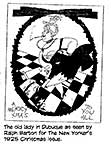
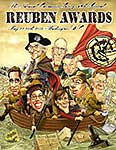
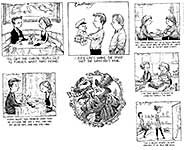
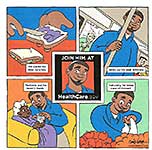

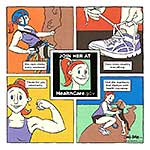
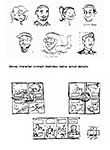
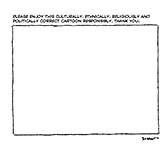
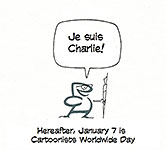
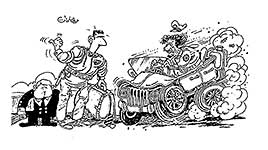
1.jpg)
2.jpg)
3.jpg)
4.jpg)
5.jpg)
6.jpg)
7.jpg)
8.jpg)
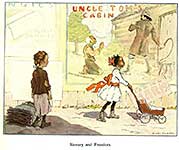
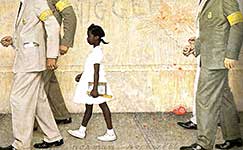
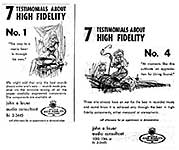
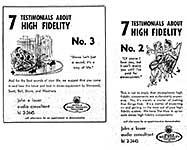
1.jpg)
2.jpg)
4.jpg)
5.jpg)
6.jpg)
7.jpg)
8.jpg)
3.jpg)
3a.jpg)
